
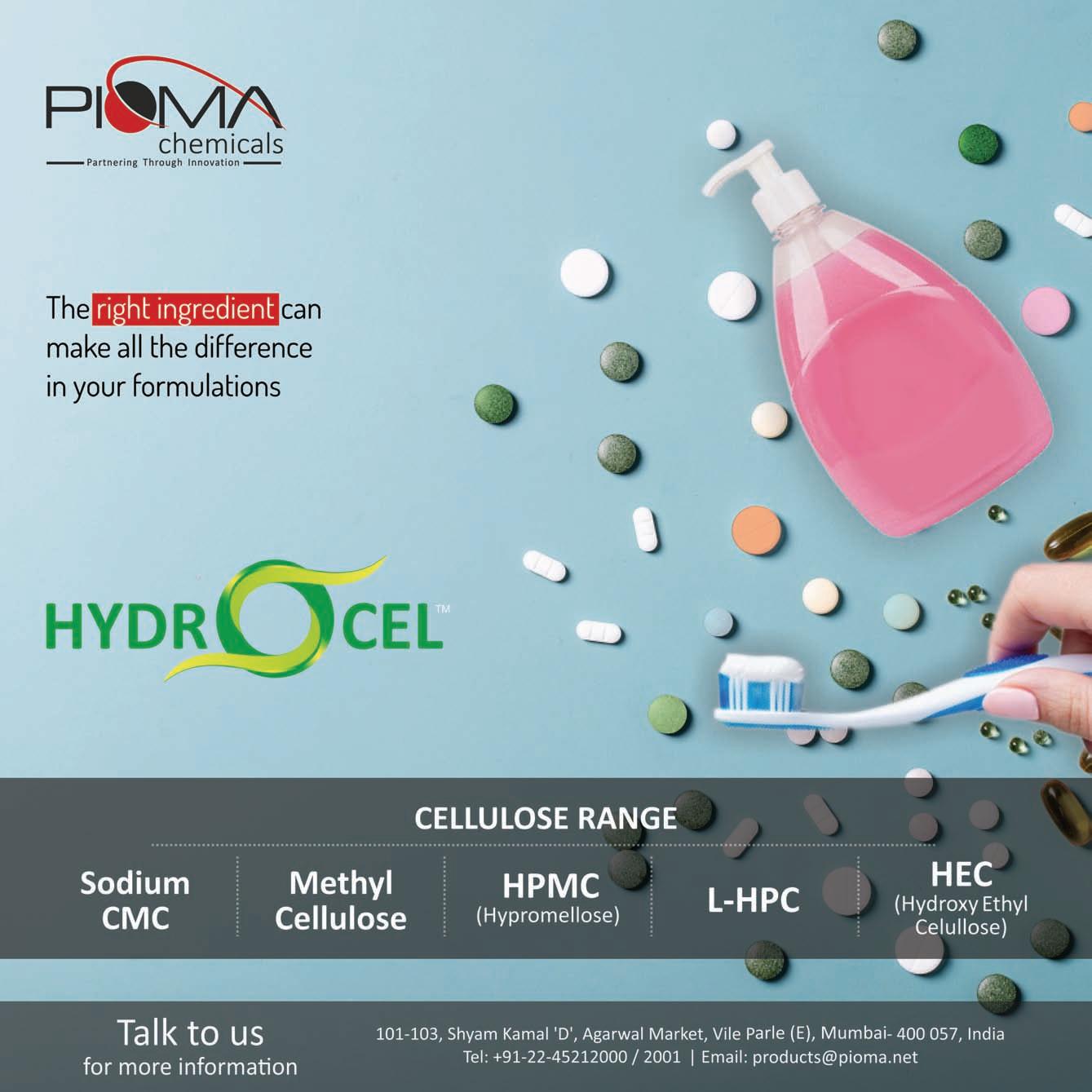
VOL.18 NO.2 PAGES 76 www.expresspharma.in
JANUARY2023,` 40 PRE EVENT Express Pharma to host second edition of Daman Pharma Summit in January COVER STORY Pharma playbook2023

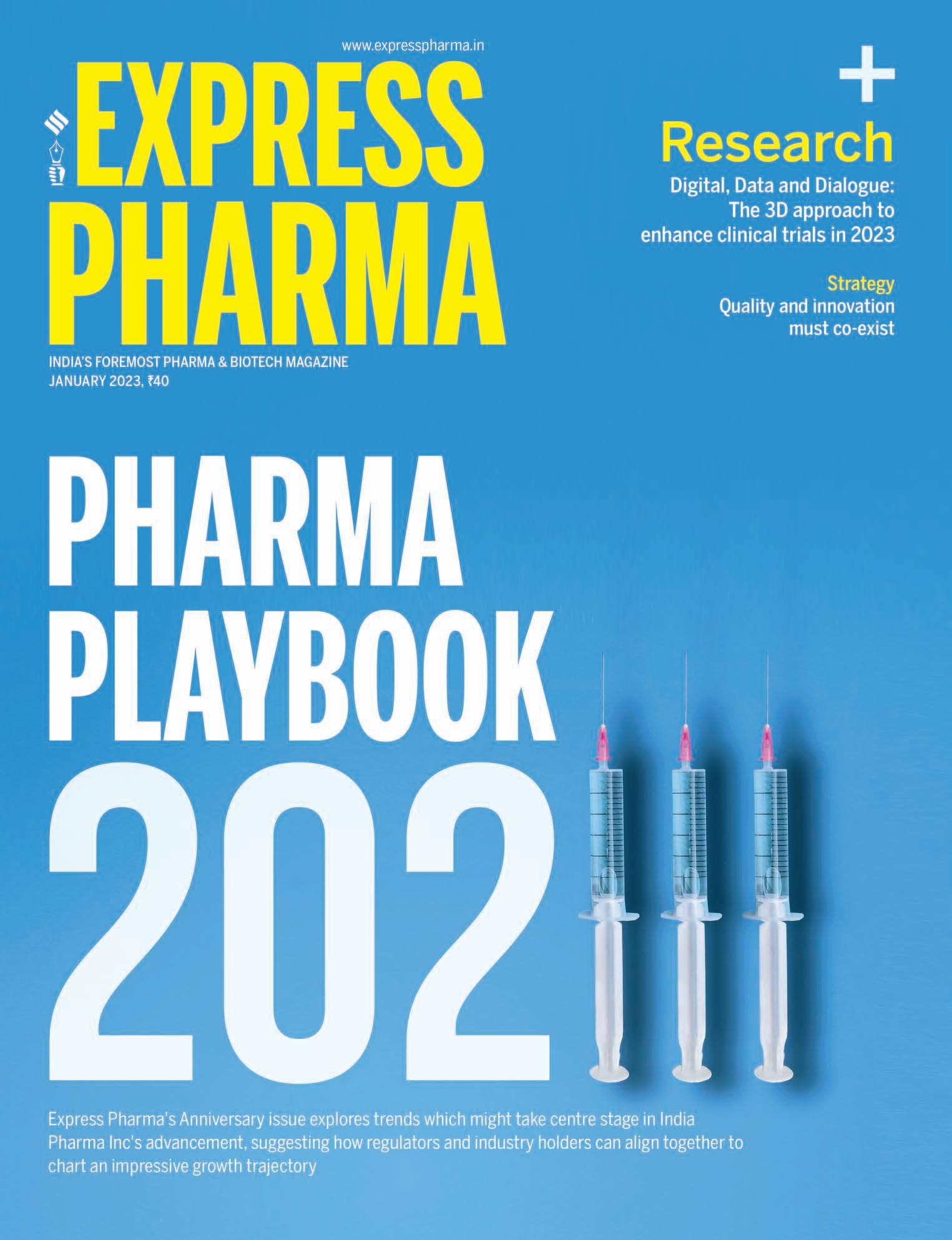
VOL.18 NO.2 PAGES 76
After its discovery in 1961 by Dr Stewart Adams and chemist John Nicholson,ibuprofen has become one of the most common painkillers used today. With a global market of $8.1 billion in 2022,this analgesic is found in cupboards,pockets and purses of billions worldwide.However,the commoditisation of ibuprofen also means that competition in the market is fierce,as generics compete with brand names,and brand managers seek new ways to differentiate their products from their competitors.
Technical experts, Joao Marcos Assis ,Global Technical Marketing Manager, and Thorsten Cech ,EU Application Lab Team Leader from BASFinform how pharmaceutical companies can stand out in the Ibuprofen market and elaborates on fast-acting ibuprofen

Ibuprofen, being a commoditised drug, has a large and competitive market. What are some ways drug manufacturers can diversify their portfolios?
There is no question that competition in standard ibuprofen is fierce. However, one way drug manufacturers can beat the competition is by diversifying their portfolio to include products in the specialty ibuprofen market –especially with fast-acting ibuprofen. Fewer players in this market means more opportunities to innovate and diversify.
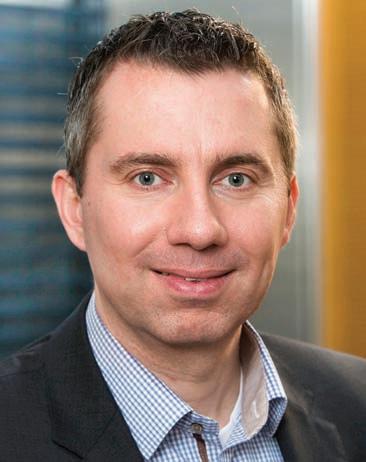
What is fast-acting ibuprofen? Fast-acting ibuprofen grades are salt forms of regular ibuprofen that are more water soluble than their standard counterparts. Standard ibuprofen exists as an organic molecule with poor water solubility, which means uptake into the body and pain relief can be slow. However, ibuprofen can also be converted into two types of ibuprofen salts: inorganic salts and amino acid salts. The former consists of ibuprofen paired with a metal – commonly sodium or potassium. The latter is similar except ibuprofen is paired with an amino acid like lysine or arginine.
How does fast-acting ibuprofen work? How is it different from standard ibuprofen? Ibuprofen salts are much more water-soluble than standard ibuprofen and, as a result, are absorbed faster and can provide pain relief more quickly. For example, racemic ibuprofen lysinate is a fast-acting ibuprofen salt formulated with lysine. In a review of clinical studies, the solubility of standard ibuprofen in distilled water is reported to be less than 0.1 per cent; in contrast, the solubility of ibuprofen lysinate is approximately 17 per cent.1 Similar results can be seen for ibuprofen sodium dihydrate, a sodium salt of ibuprofen. In vitro studies showed that this API dissolved more rapidly than its standard counterpart in various
buffers.2 Consequentially, the uptake of these fast-acting salts is also faster in the human body, resulting in quicker pain relief.3 According to the literature, pain intensity was reduced to half after 30 minutes for ibuprofen sodium dihydrate compared to 57 minutes for standard ibuprofen.3
Is fast-acting ibuprofen effective? Where is it currently sold?
With primary markets in Europe, fast-acting ibuprofen has been especially successful in Germany and the UK. Drug manufacturers have created formulations with these ibuprofen salts that target specific pains such as a headaches and menstrual cramps. Some companies claim that their fast-acting ibuprofen tablets can act twice as fast as their standard ibuprofen tablets.4 Others claim that their fast-acting products can offer pain relief in 15 minutes.5 The success these products experience in Europe indicates that there are consumers in the ibuprofen market who are willing to pay a premium for faster pain relief.
References
1. Ibuprofen, K. D. Rainsford, Taylor & Francis Ltd., London, UK, 1999.
2. Sörgel, F., Fuhr, U., Minic, M., Siegmund, M., Maares, J., Jetter, A., Kinzig-Schippers, M., Tomalik Scharte, D., Szymanski, J., Goeser, T., Toex, U., Scheidel, B., & Lehmacher, W. (2005). International Journal of Clinical Pharmacology and Therapeutics, 43(3), 140–149.
3. Schleier, P., Prochnau, A., Schmidt-Westhausen, A. M., Peters, H., Becker, J., Latz, T., Jackowski, J., Peters, E. U., Romanos, G. E., Zahn, B., Lüdemann, J., Maares, J., & Petersen, B. (2007). International Journal of Clinical Pharmacology and Therapeutics, 45(2), 89–97.
4. Nurofen.
https://www.nurofen.com.au/products/adult/nurofe n-zavance-fast-pain-relief-tablets-256mg
5. Dolormin Extra.
https://www.dolormin.de/produkte/dolormin-extra
Joao Marcos Assis
Fast-acting ibuprofen: Away to diversify your painkiller portfolio INTERVIEW
Thorsten Cech


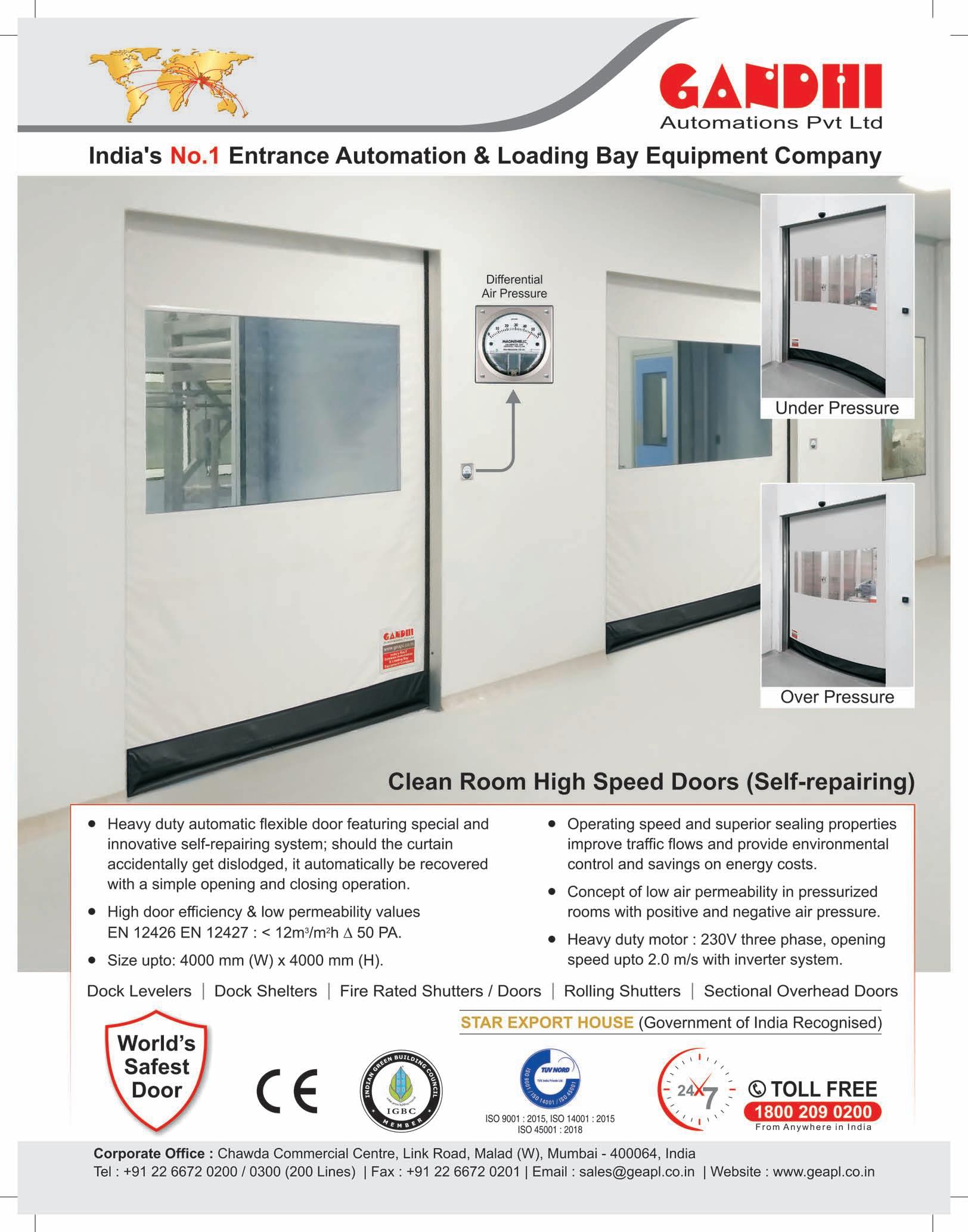

Chairman of the Board
ViveckGoenka
Sr.Vice President-BPD Neil Viegas
Asst.Vice President-BPD Harit Mohanty
Editor
Viveka Roychowdhury*

BUREAUS Mumbai
Lakshmipriya Nair,Kalyani Sharma
Delhi Akanki Sharma
DESIGN
Art Director
Pravin Temble
Senior Designer Rekha Bisht
Senior Artist Rakesh Sharma
Digital Team
Viraj Mehta (Head of Internet)

Marketing Team
Rajesh Bhatkal
Ambuj Kumar
Ashish Rampure
Debnarayan Dutta
Production Co-ordinator DhananjayNidre
Scheduling & Coordination
Pushkar Waralikar
CIRCULATION
Mohan Varadkar
Reinvigorating Goa's pharma sector
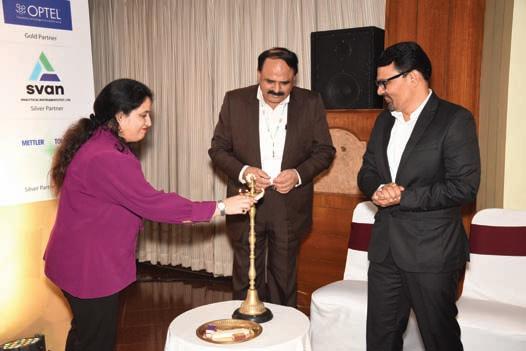
Express Pharma®

Regd.With RNI No.MAHENG/2005/21398.Postal Regd.No.MCS/164/2022 - 24.Printed and Published byVaidehi Thakar on behalf of The Indian Express (P) Limited and Printed at The Indian Express Press,Plot No.EL-208,TTC Industrial Area,Mahape,Navi Mumbai-400710 and Published at Mafatlal Centre,7th floor,Ramnath Goenka Marg,Nariman Point,Mumbai 400021.
Editor: Viveka Roychowdhury.* (Editorial & Administrative Offices: Mafatlal Centre,7th floor,Ramnath Goenka Marg,Nariman Point,Mumbai 400021)
CONTENTS January2023 EXPRESS PHARMA 9
Pg28
* Responsible for selection of news under the PRB Act.Copyright © 2017.The Indian Express (P) Ltd.All rights reserved throughout the world. Reproduction in anymanner,electronic or otherwise,in whole or in part,without prior written permission is prohibited. PRE EVENT STRATEGY 16 QUALITYAND INNOVATION MUST CO-EXIST PACKAGING 27 AIRNOVENLARGES PORTFOLIO WITH NEWAND INNOVATIVE ADDITION TO MEETEVOLVING CUSTOMERS’ NEEDS 13 72ND IPC TO BE HELD IN NAGPUR 13 EXPRESS PHARMA TO HOSTSECOND EDITION OF DAMAN PHARMA SUMMITIN JANUARY RESEARCH 34 DIGITAL,DATAAND DIALOGUE: THE 3D APPROACH TO ENHANCE CLINICALTRIALS IN 2023
Immunising India's pharma supply chain
The more things change, the more some things remain the same. China could be in for another COVID wave in 2023, thanks to a zero-COVID policy that misfired. But, inspite of having enough warnings over the past two COVID years, India Pharma Inc seems to be heading for another shortage of key chemicals used in the manufacturing of medicines. Ranging from Key Starting Materials (KSMs), intermediates and APIs, will India once again face stockouts and spiralling medicine prices? Or, have previous supply shocks helped immunise our pharma procurement systems?
API factories in China could remain leanly manned due to ill health of staff or lockdowns. The Chinese government has reportedly moved to reduce exports of KSM/API/intermediates, seeking to stockpile medicines for its own population should the COVID cases increase. As a result, certain imports from China have already seen price spikes.
It is but natural for governments to safeguard their citizens first. India did the same during the COVID vaccination drives when vaccine makers were restrained from exporting vaccines until India's population was sufficiently vaccinated.
On cue, tensions at the India-China border have also risen, as we head into winter. And, as China has stopped reporting daily COVID cases, there is no way the world has accurate information or insights on how the country is coping with the virus.
There are already warnings of the weak links in the pharma procurement chain. Reports suggest that 90 per cent of India's antibiotics are still sourced from China. Some progress has been made, but these will take time to mature. For instance, 51 companies have projects approved under the Production-Linked Incentive (PLI) scheme, which was launched in July 2020. But, to date, just around 25-30 per cent of these pharma companies have started projects. These units are set to start manufacturing operations only by 2023-24, meaning that they are more than a year away from making any meaningful contributions.
Pharma manufacturers blame the slower-thandesired takeoff of the PLI scheme on the convoluted process of getting approvals from multiple departments to start a pharma plant. This is understandable as the pharma sector does have a huge pollution problem and green manufacturing processes are more expensive.
Will China's COVID wave of 2023 serve to re-double efforts of India's policymakers and pharma makers to tackle these roadblocks? Beyond bagging a larger share of the global move to relocate manufacturing units out of China, India's pharma and allied companies have also made plans to diversify beyond China to Europe and other locations.
Fortunately, companies which heeded the writing on the wall, much before COVID, are already in a better place. For instance, according to Manoj Mehrotra, President-Pharmaceuticals, Hikal, the company's efforts to be self-sufficient are finally bearing fruits. He explained that over the last two to three years, they have
been looking at partners within India and other geographies that are not dependent on China. Though they are currently dependent on China for about 50 per cent of their KSMs, they intend to bring it down further in the next few years.
But, companies like Hikal cannot rest on past successes and will have to be constantly vigilant. Tweaking their strategies as per evolving geo-political events will be the norm rather than the exception. For instance, Hikal's plans to source some chemicals from Eastern Europe suffered a setback due to the escalating energy prices and the instability of the Ukraine-Russia conflict. Even so, Mehrotra reiterates that their long-term plan, the objective is to have a robust supply chain out of India and Europe and reduce dependence on China.
India has several companies like Hikal that are vying to be vital cogs in the global lifesciences procurement value chain. Though changing gears may initially be painful, if executed right, the gains are manifold. For instance, in Hikal's case, validation of its strategies can be gauged by deals like its multi-product 10-year contract for APIs with a global pharma company as part of the client's supplier consolidation programme. Mehrotra indicates that there is a fair chance that they may get a few more (APIs) in the next wave of consolidation. I am sure we will get to hear more such success stories as pharma companies in India find their sweet spots.

Mehrotra echoes the views of most pharma honchos that there is a lot more that can be done on the policy front. As one example, alluding to the performance of the PLI scheme, he mentions that multi-national customers feel that in India, the environmental clearance process is slow and suggests that the government should consider giving category-wise rather than product-wise approval to various manufacturing industries. One hopes that the evolving situation in China is cause enough for India's policymakers to critically analyse such approaches, while ensuring that the companies meet the global norms for environment protection and effluent treatment, etc.
If we do see a COVID wave in 2023, with some countries seeing similar infection rates following China's lead, it is another timely warning to re-focus on procurement strategies and make supply chains more resilient and agile, besides relocating to more transparent and stable regimes. The good news is that India fits the bill. The bad news is that so far, the sluggish rollout of the PLI scheme in an important priority sector like pharma does not inspire too much confidence. Let us hope that 2023 is a true watershed year for proactive and strong pharma policies, starting with Budget 2023, which are industry-friendly, but also balance other compliance norms expected of a global corporate citizen.
VIVEKA ROYCHOWDHURY, Editor viveka.r@expressindia.com viveka.roy3@gmail.com
EXPRESS PHARMA January2023 10
EDITOR’S NOTE
With China battling another COVID wave, have previous supply shocks helped immunise India's pharma procurement systems?


72nd IPC to be held in Nagpur
The 72nd Indian Pharmaceutical Congress (IPC) is being hosted by the Indian Hospital Pharmacist Association in association with the Department of Pharmaceutical Sciences, Rashtrasant Tukadoji Maharaj Nagpur University at Nagpur from 20th to 22nd January, 2023. Dr VG Somani, Drugs Controller General of India (DCGI) and President, Indian Pharmaceutical Congress Association (IPCA) believes that the theme of the conference “Access to quality and affordable medical products” aptly symbolises the Universal Health Coverage (UHC) goal of the World Health Organization (WHO).
This year, the logo of IPC was redesigned to include orange – a speciality of Nagpur and the logo of Nitika Pharma –the title sponsor of this event. Since it is being held in Nagpur this year, complimentary oranges will be distributed throughout the exhibition. A total of 12,000 people are expected to attend the pro-
gramme and 8,000 entrees have been registered. Nitika Pharma is the main sponsor of the event.
The 72nd IPC is a platform for the exchange of knowledge and ideas for the betterment of the pharmacy profession and healthcare system of India. It will provide a platform for deliberation and discussion on some of the latest and interesting developments in the field of pharma science, including medical devices, blockchain technology, Artificial Intelligence (AI) and automation in the pharma industry, HVAC/track-andtrace mechanism, MSME, manufacturing industries and packaging industry. The congress would also touch upon pharmacovigilance, pharmacoeconomics, pharmacogenomics, API
and excipients, nanotechnology, medical coding, regulatory affairs, geriatric and paediatric medicare, biosimilars, cancer, cosmeceuticals, nutraceuticals, Ayurveda and personalised medicine. This conference will bring together advancements in pharmaceutical, medical and pharmacological sciences, drug discovery and health education.
As a part of the congress, a CEO conclave will also be hosted on the topic "Vision Pharma 2050," which will be attended by many CEOs like Madan Mohan Reddy from Aurobindo Pharma, Aditi Kaare from Indico Remedies, Dilip Sanghvi from Sun pharma, Yogesh Agrawal from Ajanta Pharma, RC Juneja from Mankind Pharma, among many more. Purushottam
Agrawal and Ajit Singh are the mentors for this event that will be conducted by Ravleen Singh Khurana, CEO, Nitika Pharma. Apart from it, there will be an exhibition showcasing the technical strength of excipient manufacturers. They will highlight the facilities, equipment, instruments, etc available with them and kind of services they offer in their application lab. They will also bring small instruments and equipment for display to make their pharma customers aware about their technical capabilities. Apart from Nitika, companies like Ajanta Pharma, Zim Laboratories, Colorcon, Merck, Ideal Cures, Gencrest, Sun Pharma, Blue Cross, Novartis, All India Organization of Chemists and Druggists (AIOCD), Nagpur
District Chemist and Druggists Association (NDCDA) and Pfizer, among many more, are the industrial partners.
The International Pharmaceutical Excipients Council of India (IPEC) will also be conducting a special session during IPC. The six-hour session will be given by internationallyacclaimed excipient companies. Ajit Singh, Chairman, ACG Pharma, will begin the session as the first keynote speaker. Nitin Gadkari, Union Minister, Road Transport and Highways, will be the Chief Patron and Chief Guest for the event.
Dave Shonekar, President, IPEC, will also be a part of the event. In addition, Pfizer has invited three international speakers as it is the partner for scientific session. The lectures in the session will be about space pharma, nanotechnology, enzyme and biotechnology and other such interesting topics. The expo will consist of machines, instrument and will also have corporate pavilions.
Express Pharma to host second edition of Daman Pharma Summit in January
Daman Pharma Summit will bring leaders,experts and veterans of the pharma sector together to deliberate upon the opportunities and challenges in the Union Territory (UT)
D aman, with its proximity to major cities like Mumbai and Surat, good connectivity via road, rail, air and water, growing infrastructure and conducive business climate, is key to the pharma sector as well. Consequently, a plethora of pharma companies has set
up bases in the union territory. Therefore, Express Pharma, a leading industry publication from The Indian Express Group, is organising the 2 nd Daman Pharma Summit on January 20, 2023, at The Deltin Hotel, Daman.
Daman Pharma Summit
will bring leaders, experts and veterans of the UT's pharma sector together to deliberate upon the opportunities and challenges in the UT, discuss strategies to optimise growth potential and share learnings from the COVID-19 pandemic to enable sustained progress
in a rapidly changing global milieu.
Daman Pharma Summit 2023 will witness industry experts and veterans reflecting upon: ◆ Strategies to make and innovate in India ◆ Emerging opportunities
and growth drivers in Daman ◆ Sustaining cost leadership with product excellence ◆ Quality: The cornerstone for growth ◆ Best practices for regulatory and growth ◆ Building future-ready pharma facilities
January2023 EXPRESS PHARMA 13
PRE EVENT
The congress is being hosted by the Indian Hospital Pharmacist Association in association with the Department of Pharmaceutical Sciences from 20th to 22nd January
NEWS
Atotal of 12,000 people are expected to attend the programme and 8,000 entrees have been registered
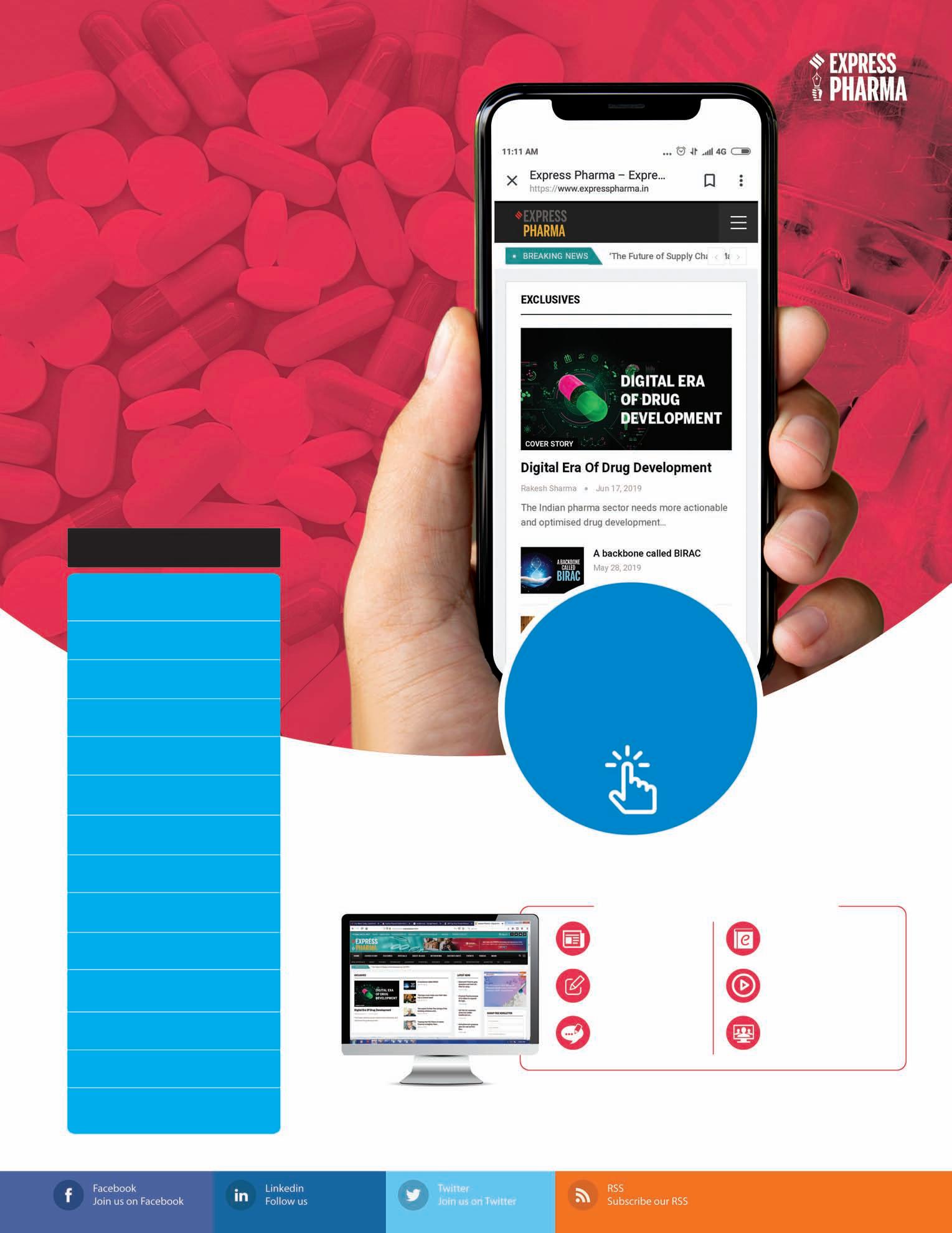









STRATEGY
OPINION
Qualityand innovation must co-exist
Necessity is the mother of invention is an old phrase but holds true in the 21st century too, and this is what leads to the belief that quality and inn ovation must co-exist to improve standard of living, affordable drugs for the masses and in reference to the pharma industry, increase our efficiency and effectiveness. As a matter of fact, today, this is not an option for those of us who want to be relevant and sustain our organisation.
Whyinnovate is the question?
The landscape in the pharma industry is not as rosy as it used to be in the 80s. We are witnessing pressure on both sides of the price equation in that. At one end, we see significant price erosion for generic drug products, and, on the other, exorbitant prices for innovative drugs. Most governments are pushing down prices for all the right reasons, competition is becoming fierce, manpower cost is burgeoning, supply chain is having trouble due to geo-political environment. A combination of all these factors makes for a challenging environment, particularly for those who want to excel or even stay relevant. Thus, what is the panacea for the pharma industry? This is where innovation comes into play, and, as an avid practitioner in this industry, I will be the first to assert that quality must be intertwined in everything we do. In this case, I am writing about inn ovation and quality in the same breadth.
Where do we start? In my opinion, a great place to start is where value gets created day in day out in R&D, on the manufacturing floor, followed by the Quality Control (QC) laboratories. We also know
and have witnessed manufacturing shop floor and our labs
to be fertile ground for potential error, and we go to great lengths to prevent errors. These are the areas to start innovation. Specifically, in the R&D labs, bring in innovation for better predictability of clinical studies, study the various formulas by modelling, and then, go further with the most successful formulas.
Once in manufacturing, let’s begin with—what can be automated, digitised and where will the innovation give us maximum return in terms of speed, accuracy, error proofing and consistency. If we could innovate in a manner where there are in-built interlocks between discrete steps, we could avoid/eliminate errors. Our endeavour, when we get ready to bring in innovation during the design phase, it is strongly recommended to ensure such interlocks get built in the design phase. The same is true for the QC laboratory, during design phase –be it LIMS or any other system, ensure the interlocks are built in, so that the first line of defence is equipped with the tools to have “right first time” outcomes.
There are some who have made huge advances in innovative processes, removing the reliance on humans. The benefits of such innovation is huge, innovation done well is directly proportional to productivity and good quality becomes an output.
The hesitation to innovate by companies is the fear of regulatory bodies or simply existing regulations. These hurdles are easily overcome, just as industry wants to get efficient and be more productive, the regulators today worldwide welcome innova-

EXPRESS PHARMA January2023 16
Dr Ranjana Pathak,Head – Quality and Pharmacovigilance,Dr Reddy's Laboratories,asserts that quality and innovation must be intertwined in everything we do,urging companies to start where the innovation gives maximum return in terms of speed,accuracy,error proofing and consistency
There are some who have made huge advances in innovative processes,removing the reliance on humans.The benefits of such innovation is huge, innovation done well is directly proportional to productivity and good quality becomes an output
tion, particularly when it can be demonstrated that the drugs can be manufactured consistently keeping the same or higher quality standards. This would also prevent drug shortages because of the predictability of manufacturing.
Role of regulators
Our principal stakeholders are our patients followed by our regulators and our employees.
The regulator plays a huge role in advancing our industry through policy making in line with new technology that uses innovation. The relevant pharmacopeia may not have these tests or methodologies, but this should not be a deterrent for us to shy away. As we saw during the pandemic, the unison and collaboration between regulators and industry was the first of its kind. Drugs/vaccines were being developed and approved in record time and millions of lives were saved. We need to be able to replicate this during normal times to advance our industry.
For the industry to advance, become efficient and competitive, the level has to be made, even in that, the laws must be enforced as consistently as humanly possible. New methods must be approved expeditiously; it is tied up with inn ovation and quality. When companies innovate, the regulator needs to bless it, so that the companies can reap the benefits.
For example, there has been very little innova tion in the microbiology laboratory until recently. There are new techniques and methodologies to reduce the time drastically for microbial limit test and sterility tests. The use of technology during manufacturing is to avoid bringing samples to be tested by QC; we should embrace Raman/NIR technologies to assess if the tests can be done on the shop floor. These have been discussed and written for a few years now. PAT has become an old word, yet, not even 50 per cent of the companies have adopted it. These are just a few examples.
Role of industry associations
The industry body plays an equally vital role in raising awareness across the industry by organising seminars and workshops at affordable prices, encouraging young scientists, help in training, etc.
Innovation cannot be
achieved in absence of technology. Sometimes, it seems that technology is lagging, and, that may be due to cost.
Technology is trying/enabling us on the shop floor. There are some technologies available for sample preparation, but they are difficult to
use and maintain. We need to be able to simplify usage for the average worker/chemist/operator to rise.
In summary, quality and innovation are intertwined to enable our factories, ways of working to be deft, errorproof. This will yield highly
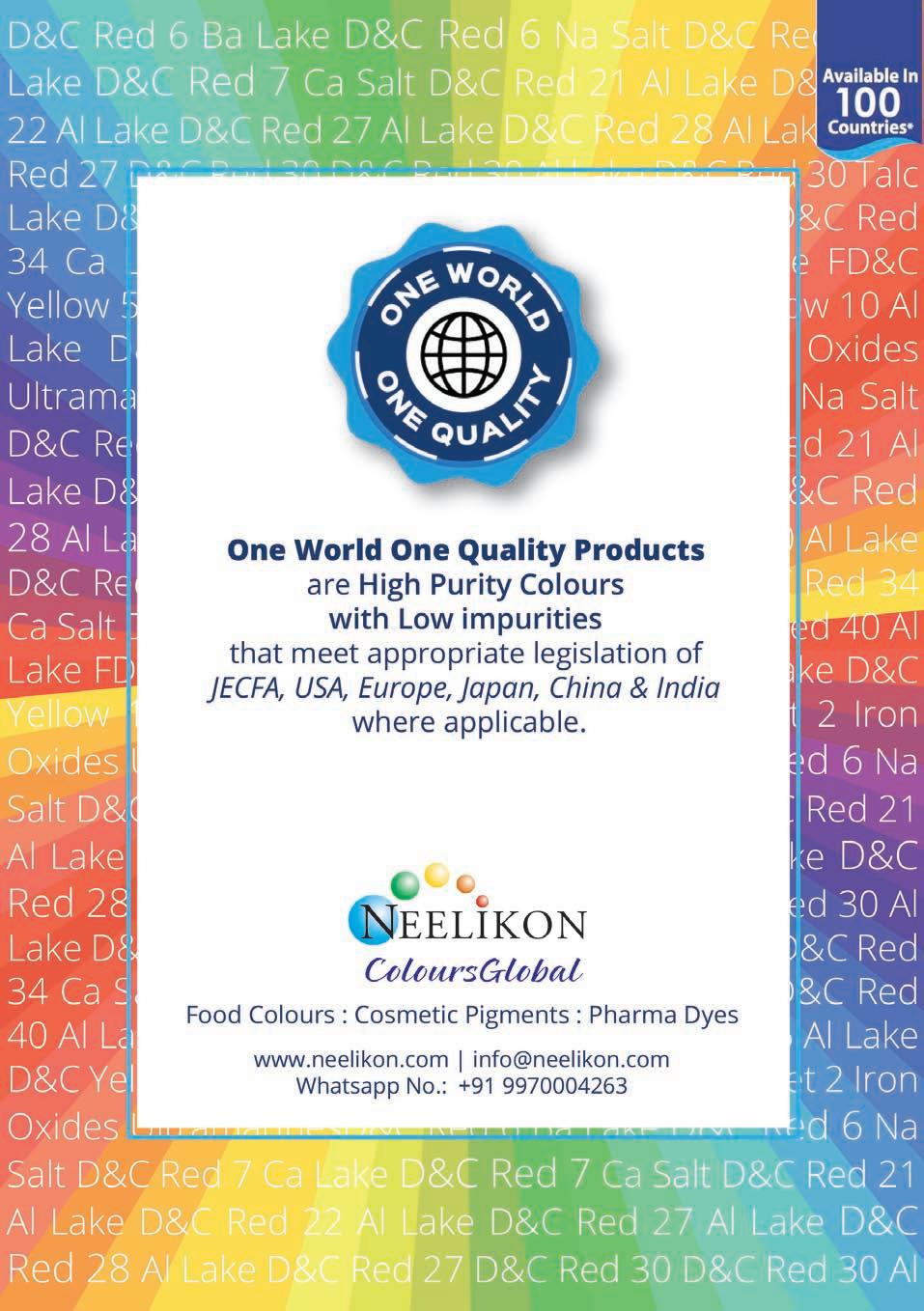
productive factories, people will have joy in their work, the rate of errors and complaints will drastically reduce and the level of compliance will be a natural outcome.
Let us be bold and dream with our eyes open and make this happen!!!
Here’s to innovation.
January2023 EXPRESS PHARMA 17


EXPRESS PHARMA January2023 18 cover )
The pharma playbook is evolving rapidly to become more agile and responsive to the new market realities and demands of healthcare across the globe.The sector is increasingly looking at new strategies and approaches to enhance process and product efficiencies, improve the expertise of human resources, leverage technology to optimise both,cost and quality of outcomes,as well as encourage scientific innovation.
So,as we enter a new year, ExpressPharma's January 2023 issue,which is also our Anniversary issue,examines and explores trends which will take centre stage in India Pharma Inc's advancement.The issue analyses how regulators and industry holders can align with each other to chart an impressive growth trajectory.
 By EPNews Bureau
By EPNews Bureau
January2023 EXPRESS PHARMA 19
For the pharma industry, maintaining a reliable supply of high-quality medications for the patient population and other end users is a top concern. One scrutiny by the US Trade Representative (USTR) found over 20 per cent of the drugs in the Indian market to be fake. According to a report by the non-profit Authentication Solution Provider’s Association (ASPA), incidents of substandard and falsified products increased by 47 per cent during the peak of the pandemic from 2020 to 2021.
It is of prime importance to ensure that the quality of the processes that manufacture these drugs, along with the quality of the drugs, is maintained, as this will only help India achieve its health goals faster and more efficiently. Moreover, sub-standard drugs can have a catastrophic impact on human health as they can
cause diseases to run a longer course and contribute to the escalating incidence of anti-bacterial resistance.
Current issues: Counterfeiting drugs is a global menace that is estimated to cost the Indian economy Rs 1 trillion annually. While falsified drugs resemble the original brand in looks, they are nowhere as efficacious, and can have an adverse impact as they contain poor doses of the prescribed active pharma ingredient. The pharma industry in India has, however, recognised the need for a proactive and unified quality management approach to mitigate risks and deliver breakthrough drugs. Industry standards such as Good Manufacturing Practice (GMP) and Schedule M (of the Drug and Cosmetics Act 1940), which lay down quality control metrics for production, facilities and equipment, laboratory con-
trols, materials, packaging and labelling, are already in place.
Moreover, the Indian government has set up a sevenmember panel to prepare the country’s first-ever National Drugs Database. The registry will empower consumers and improve monitoring by providing information such as on a drug’s dosage, form, strength, manufacturer, marketer and importer. On the other hand,
the health ministry has also changed the Drugs and Cosmetics Rules to make marketing companies equally accountable for drug quality, apart from the manufacturer. This will also call upon small manufacturers to up their quality game and take a stand against fake and spurious medication.
Future recommendations: It’s crucial to serialise or provide the smallest usable unit of a pharma product, a distinct identity. It makes it possible to discover the product's past and present locations throughout the whole supply chain. Even blockchain technology might be taken into consideration for the entire network of medicine manufacturing, distribution and sales, preventing the entry of counterfeit and subpar medications. From an overarching perspective, the pharma production process itself needs to be subjected to stricter inspec-
tion and control to prevent the deterioration of the quality at any step. In the coming year, as a step towards enhancing the overall quality, providing financial assistance through loans and subsidies for pharma industry units to upgrade their manufacturing, infrastructure and systems to prevent the quality from depreciating right from the development of the pharma product to the lastmile delivery to the end customers: patients, could help.
India is taking strides in the right direction, with a lot more focus on product monitoring and quality of APIs. Stakeholders and policymakers also need to take collective action to ensure regulation and compliance. Both the industry and the government are driving the quality revolution in India by making it a cornerstone for the industry’s and the nation’s progress.
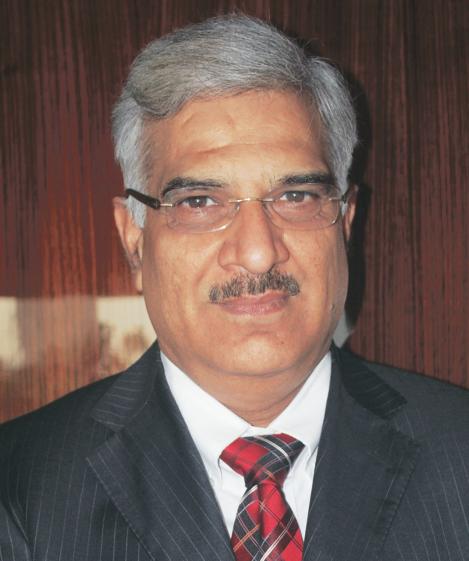

Digital age requires new concepts and methods to compete in business and support the economy
As COVID-19 becomes an endemic virus and economic considerations keep revenue and margins under pressure, new regulatory developments are emerging. Although the lifescience industry has never been at the forefront of digitisation, the COVID-19 pandemic has pushed it to catch up swiftly. The sector now recognises the value of delving deeply to learn about standardising and modernising insight-gathering procedures, embracing novel strategies for problems, and implementing purpose-built technology throughout the drug- and device-development process, from early-stage R&D through
post-market surveillance.
Digital transformation paves the way for the quick implementation of Industry 4.0 pillars and concepts in pharma manufacturing. In the digital age, new concepts and methods are required to compete in business and support the economy. Robotics, Artificial Intelligence (AI), Machine Learning (ML), blockchain and the Internet of Things (IoT) are just a few of the technologies that the digital transformation has introduced to the industries and which aid businesses in improving their levels of performance, transparency and security. However, blockchain technology has the
potential to have the biggest impact of all by managing logistics and inventories as well as reduc-
ing challenges with forging and theft. In the pharma supply chain, this is indeed important.
A few of the major trends will have a huge impact on how the pharma sector is going to transform in the future.
A competitive shifting landscape: Pharma businesses across the world are using cutting-edge ML algorithms and AIpowered platforms to accelerate the drug discovery and development process. Additionally, it simplifies and lowers the cost of cohort identification. As a result, pharma companies are looking at ways to use these technologies to address a range of problems, including the automation and
optimisation of manufacturing processes for higher productivity, more efficiency, and a speedier turnaround on the production of life-saving drugs.
Rising role of precision medicine: When compared to other approaches, using precision medication has proved to be more successful. With the help of data analytics, researchers may be able to develop personalised treatments using an evergrowing collection of medical data. Precision medicine's speciality is shortening clinical trials' duration, expense and failure rate. Even though there is not much competition in the industry currently, given the
EXPRESS PHARMA January2023 20 cover )
It’s crucial to serialise the smallest usable unit of a pharma product, a distinct identity
VivekSehgal,DG,OPPI
Suresh Pareek,Founder, Ideal Cures,and co-founder, Elephant Canvass
opportunity and the size of the market, it's likely that mid-sized and smaller enterprises will enter it and provide new technology. The number of investors that support precision medicine has exceeded expectations.
Programmatic Clinical Trials (PCTs): Conventional drug trial models were put to test by the spread of COVID-19, necessitating a change to more patientcentred clinical trial designs, a rewriting of protocols to allow remote volunteer monitoring and in-home delivery, as well as the implementation of other digital capabilities, like telemedicine, to maintain clinical research viability. Programmatic Clinical Trials (PCTs) are outcomes-based, patient-centred investigations that compare the benefits and drawbacks of therapeutic interventions to support clinical and/or policy decisionmaking. Companies may engage with patients and inform them about each phase of the investigation process through the usage of blockchain technology. The technique can facilitate clinical study because it stores patient data. Clinical trial procedures can also be made more understandable to patients and other stakeholders.
Evolving regulatory landscape: The sector was undergoing significant regulatory change prior to the pandemic; in the post-COVID-19 environment, it now faces new challenges and priorities. Drug counterfeiting is a significant problem for the industry, and regulators continue to put pressure on businesses to lower their pricing. Because of this, the sector now needs to create tighter supply chains to ensure complete traceability at every stage. Given all the operational and regulatory constraints placed on the supply chain operations, it is imperative to include blockchain technology to resolve these problems and bring qualitydriven, cost-effective products back to the market. The Regulatory Information Management (RIM) framework's simplicity is another issue the sector has. The industry requires solutions that can help with precise event
capturing, action triggering, workflow management, notification management and record update control, all the way down to process automation. In order to accomplish long-term goals,
these procedures can be streamlined using a variety of automation technologies, including cognitive and deep Machine Learning (ML), Robotic Process Automation (RPA) and cognitive
automation. Accuracy and transparency in supply chain: The most significant challenge facing every industry is effective supply chain management. The lifesciences
industry, however, is more advanced and vulnerable since a contaminated supply chain might endanger patient safety. Particularly in pharma, there are numerous stakeholders and
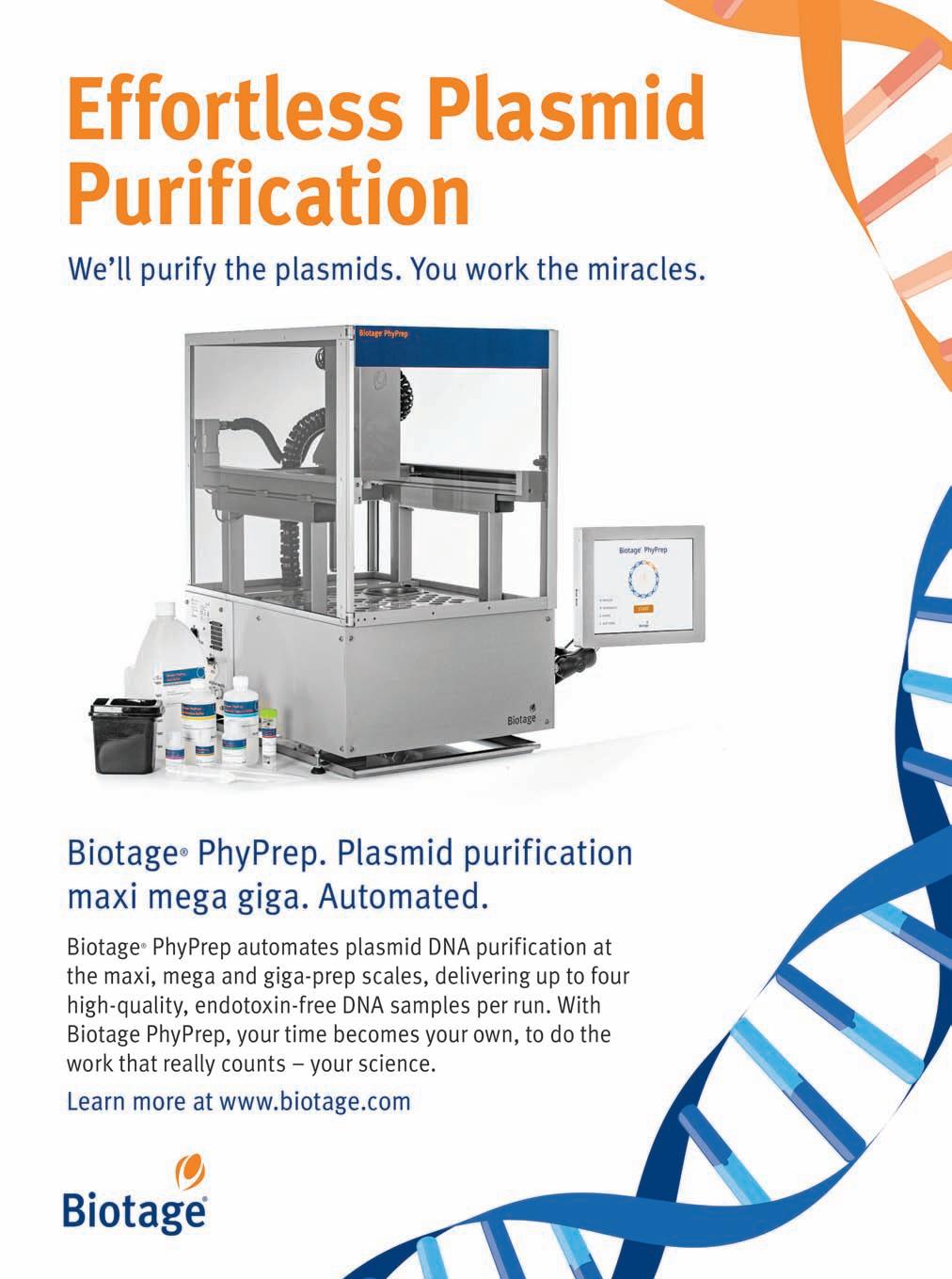
January2023 EXPRESS PHARMA 21
stages involved, i.e., from the API source to the drug manufacturer, packaging and distribution businesses and regulators, all the way through to hospitals, pharmacies, and finally, the patient. With so many intermediaries, the distribution chain is more likely to become complicated, making it challenging to track and verify authenticity. Blockchain technology would be able to demonstrate the provenance of products and offer higher security. In the pharma supply chain, it can control inventory and lessen difficulties with theft and counterfeiting. Enhancing production efficiency: Lifescience organisations utilise cutting-edge technologies to streamline their production procedures as competition heats up and regulatory requirements change. Businesses must evaluate how they can use their limited resources effectively as the scenario continues to change. Re-evaluating the ratio of internal capabilities to strategic outsourcing relationships may lead to both, opportunities and useful solutions.
THREE KEYLESSONS
1.Upskilling pyramid adoption: Bytraining the leadership first,it is ensured that theywill serve as the coaches and mentors of their respective teams,which aids in creating an environment where upskilling is valued.Additionally,lifesciences businesses must periodicallytrain their employees on newtechnologies and skills that are becoming necessarydue to a changing workforce.
2.Financial management: Byusing business intelligence techniques and tools like Machine Learning (ML) and advanced analytics,finance departments mayleverage previous data records more successfullygoing forward.The shift to a data-driven decision-making process will formalise the importance of reliable and clean data in everychoice.
3.Remain competitive without compromising on qualitystandards: Drug manufacturers must have a comprehensive approach to companyoperations that takes into account processes, regulatoryrequirements and technology,in order to succeed.In this digital era,newideas and techniques are necessaryto be competitive in business and assist the economy.
For instance, the manufacturing process for pharma is intricate and comprises a variety of equipment, including auxiliary equipment, building systems, and heating and cooling systems that can increase production. Rather than purchasing new machinery, organisations should focus on effective maintenance programmes and strategies to make the most of
the existing equipment and increase output.
Reassessing the business model: Technology developments and the rise of digital platforms are transforming how businesses operate in the global market. In order to increase the productivity and efficiency of enterprises, the new- age technological explosion has made it possible for business and the
digital platform to be considered interchangeable terms. Finance teams can more successfully use past data records in the future by utilising business intelligence techniques and tools like ML and advanced analytics. This makes it feasible to develop sophisticated forecasting models that produce insights that are more accurate. Importantly, this transition to a data-driven
decision-making process will formalise the significance of clean and accurate data in all decision-making.
Conclusion
Lifescience organisations need to master not only the science and the ability to innovate, but also the capacity to scale up to industrial levels to compete. Assessing the direct and indirect effects on a company's operations can help companies decide whether to invest in or source out the new biocapabilities that are coming into the market. Regardless of the decision that turns out to be the best one, businesses will need to increase their understanding of the newage revolution to recognise, evaluate and operate in this growing market. Similar to their digital predecessors, businesses with expanding biological data sources are now incorporating automation and ML to hasten and diversify scientific findings. Blockchain will eventually modernise the industry and integrate into every major pharma company.
Post the COVID-19 pandemic, pharma industry has introduced new focus areas
The pharma industry has undergone tremendous change due to the pandemic in the past few years. In 2023, the pharma sector will focus on sustainability, mainly on sustainable packagingof the products while balancing consumer safety as the eco-friendly option,equity in healthand accessibility for patients.
The world is moving towards a greener tomorrow with the concept of sustainability, where the need of the hour is met, but without compromising the needs of the generations to come, ensuring that there is always a balance between the advancement of technology and the well-being of the environ-
ment. At the forefront of the pharma sector, work onsustainable packagingis in the works as the packaging creates the first impression of the brand and its transparency towards its claims of sustainability and aesthetic appeal. Still, the pharma industry is moving at a relatively slower pace than the other packaged goods sector due to consumer safety of the products standing at the forefront of the issue. The level of exposure to different environmental factors, temperature, oxygen, sunlight etc., plays a significant part in protecting the patient by ensuring that the product is being consumed safely.
Pratima Reddy, Managing Director, MerckSpecialities

Recently, there have been developments in the area,
which give us hope that we will soon be able to shift to a biodegradable form of packaging completely. This will be done without hindering the safety standards of the products by optimising the dimensions and recyclability of our packaging while keeping our products fit for consumption. At Merck, we aim to reduce any adverse impacts our medicines may have on the environment during their development, manufacture, transportation, use and disposal.
Accessibility to healthcare for patients has always been at the forefront of the company, but, at the same time, we are striving towardsequity in
health. This not only helps the patients enormously, but, at the same time, equity will ensure that every pharma company will have a level ground to establish itself in the market. In addition, the sector holds the capacity to identify needs according to age, geography and treatable and untreatable health conditions to identify their target markets across the globe.
Identifying such factors has equipped pharma companies to invest more effectively in their areas of expertise as it varies from region to region drastically. In economies like India, where there is a vast potential to expand the market, the value
EXPRESS PHARMA January2023 22 cover )
proposition from approaching equity in health becomes beneficial while inducing much-needed trust among the citizens.
Accessibility of patients in healthcareis the ultimate aim of every pharma company as patients are the centre of everything that we do for patients to trust us and our research to cure the unique problems of the healthcare community.
Within the pharma industry, accessibility to patients has always been defined as a service that the sector can provide to patients in need, a provider of medication, an institution to approach in distress and the appropriate services that can address the needs of the patients. The sources of healthcare are
on capability building by creating partnerships with National payers such as Employees State Insurance Corporation (ESIC), under the Ministry of Labour and Employment and the Min-
istry of Railways to develop pathways for access. These strategic partnerships with multiple state governments to include our medicines under the access initiatives have
helped us reach out to the remote areas of the country with the quality drugs that patients around the nation need.
These factors and the choice of each company in the pharma
industry will have a lasting impact on the patients we serve across the world. Especially, post the COVID pandemic, the industry has introduced new focus areas.
to be distributed across the areas with the resources to resolve the healthcare issues.
Merck has initiated the National Payers Partnership programme on cancer care, an avant-garde programme in the oncology segment with a focus

January2023 EXPRESS PHARMA 23
At the forefront of the pharma sector,work on sustainable packaging is in the works as the packaging creates the first impression of the brand and its transparency towards its claims of sustainability and aesthetic appeal
The power of AI is the future of pharma
New-age technologies like Artificial Intelligence (AI) and Machine Learning (ML) are poised to play a transformational role in the growth of the Indian pharma industry by expediting drug development and discovery and enhancing efficiencies. While leading global pharma giants have already started using AI in a big way, Indian pharma majors are also fast catching up.
AI, coupled with big data and ML, is veritably the future of pharma. Encompassing all pharma processes ranging from drug research and manufacturing to marketing and supply chain management, AI applications are proving instrumental in bringing down costs, supporting a profit-driven innovative ecosystem and enhancing productivity, thereby, business outcomes, as more and more Indian firms jump on
the digital bandwagon.
They have started leveraging the power of AI by analysing vast amounts of data to improve business processes through decisive insights, boost the success rate of new drugs through quality control and address supply chain issues in the production line, thus cutting down on wastage. AI tools also help minimise the scope of human error to ensure greater efficiencies, reduce operational costs through predictive maintenance and make way for more cost-effective drugs by streamlining the working processes. Evidently, AI-powered analytics can go a long way in improving the value proposition by creating innovative business models.
Pharma companies are also increasingly using AI to streamline the drug discovery process by simplifying the practice of identifying complex
By 2023,
Saransh Chaudhary, President,Global Critical Care, Venus Remedies,and CEO, Venus Medicine Research Centre
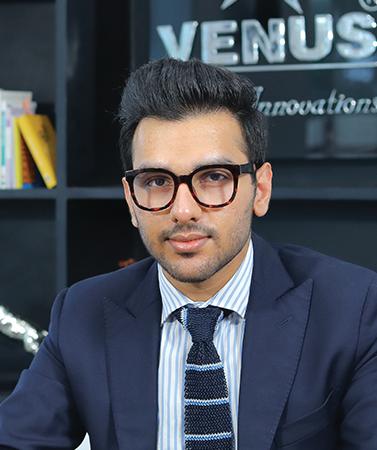
patterns from datasets to assess the safety and efficacy of drug candidates and applying them to solve problems involving complex biological networks. The predictive and data analytics capabilities of AI enable drug researchers to assess the implications, benefits and success rate of new drugs by analysing dataset patterns.
Likewise, machine learning also plays a crucial role in realworld evidence studies and clinical trials through techniques like few-shot learning, which involves inferring the results on the basis of restricted data in the process of testing experimental drugs and zeroing down on drug candidates with the highest potential. These technological interventions not only do away with the need for large datasets, but also put the drug discovery and development process on fast track.
Going beyond drug discovery, AI can also help analyse and imp rove upon marketing campaigns by providing measurable results and accurately predicting the success rate of marketing activities. Likewise, it is redefining the scope of interactive digital tools in the consumer healthcare space.
Companies catering to
consumer healthcare are increasingly opting for datadriven personalisation and immersive technologies like Virtual Reality (VR) and Augmented Reality (AR) to enhance patients’ experience by interacting with them and providing solutions based on their feedback. Automated patient-decision aids, for instance, employ cognitive AI with evidence-based insights gained from patient history or interactive questionnaires to understand the critical issues that need to be discussed with physicians. Going a step further, we also have technologies like precision health, virtual health assistant and emotion AI, also referred to as affective computing, which will also be crucial in improving targetted and personalised care for critical diseases, another key area that will witness an upward trend in coming years.
pharma industry is expected to be worth
more than $1 trillion
The pharma industry has experienced tremendous growth in recent years, and the outlook for 2023 remains optimistic. By the following year, the industry is expected to be worth more than $1 trillion. This is due in part to the thousands of compounds currently in the final stages of clinical development, as well as hundreds of new products with approvals expected in 2023 and beyond. This level of pharma products is unusual, and hasn't occurred in over a decade.
AI is a term that is gaining traction across all industries. It is the use of computer systems to perform tasks that would normally require hu-
man intelligence. Decisionmaking, speech recognition and visual perception are examples of such tasks. It also allows for information to be translated between different languages. The use of AI in pharma industry is expected to expand in various roles, such as accelerating drug discovery and development. clinical trials, fraud detection and overall medication improvement are some of the areas that will benefit from AI.
As blockchain technology has grown in popularity in the financial sector, companies in the pharma industry have begun to explore new applications for it. The primary goal of blockchain technology is to
Raheel Shah, Director,BDR Pharma

simplify transaction processing while also improving security and transparency without the need for a third party. Blockchain technology, when used by pharma companies,
can help boost efficiency by streamlining processes. This is true for transactions involving medical clinics, hospitals, regulators and other stakeholders. It can also improve the results of research and development.
Medication pricing will occasionally make headlines, especially when there is the outrage over the high cost of life-saving drugs. The examination of drug prices and continued scrutiny to detect impropriety will continue in 2023.
One of the operational trends that will grow in 2023 is the use of digital training to ensure the proper and efficient use of implemented
technologies. This is also done to ensure regulatory compliance. Pharma companies and pharmacy employees, like those in any other industry, must be well-versed in regulations and be able to navigate the various systems put in place in a way that complies with them.
There is a greater emphasis on the worth of medications. As a result, pharma companies are more concerned than ever about ensuring that research and development are directed in the right direction. There is an effort to improve effectiveness and efficiency in meeting patients' needs while also protecting the bottom line.
EXPRESS PHARMA January2023 24 cover )
Top trends in pharma marketing in 2022 will continue to dominate the sector in 2023
The pharma sector has evolved rapidly during the COVID-19 pandemic and became more agile and responsive to the new market realities and demands of healthcare across the globe. As digitisation transformed the whole healthcare sector across the globe, technology disruption in pharma also contributed to new developments in this space. The sector is now increasingly looking at new strategies and approaches to enhance the process and product efficiency.
Top trends in pharma marketing in 2022 like patient-centricity, personalisation in healthcare solutions and changing relationships between healthcare providers and patients will continue to dominate the sector in 2023 as well. The pharma sector is an evolving space with a focus on improving the expertise of human
resources, leveraging technology to optimise both, cost and quality of outcomes, as well as encourage scientific innovation.
As we step into 2023, the trends that will take centre stage in India’s pharma setup and the new market realities for the sector are:
Digital transformation (Use of AI and other new-age technologies) : With the pandemic having a ripple effect, the digital transformation of the pharma sector will take a centre stage in 2023 as one of the trends. There is no doubt that the latest technologies such as Artificial Intelligence (AI), AR/VR, Machine Learning (ML) and additive manufacturing are helping pharma companies. This includes conducting trials in less time, improving the R&D process and adding innovation to the products as well as improving compliance and efficiencies in manufacturing.
Nikkhil KMasurkar, CEO,Entod Pharma

More innovation and R&D: To move up the value chain, the pharma industry needs to focus on innovation. The sector needs new product launches and a strong innovation pipeline every year, along with more Research and Development (R&D) for emerging diseases or infections. The idea should be to have a core focus on patient needs while enhancing pharma’s significance in new
drug development, biologics and innovation. Pharma companies are also expected to put more focus on the usage of technology, biological sciences, and cell and gene therapy, as part of the trend.
Personalised medicine: When medication is produced based on a specific patient diagnosis, it refers to personalised medicine. The purpose is to ensure the drug is tailored for optimal effectiveness and patient outcomes. Reportedly, precision medication has demonstrated a higher level of effectiveness than other options. However, the problem that manufacturers are facing is that a smaller quantity of medication is produced, which means there is more than one-treatment variation.
The production of precision medicine requires facilities that are specialised and smaller than most factories. The year 2023 is expected to
give space to this trend as the methods used to produce precision medicine are refined, though it has posed problems for manufacturers. Regulators and industry stakeholders need to align with each other: To take on the new challenges and grab opportunities in 2023, regulators and industry stakeholders can align with each other, to chart an impressive growth trajectory. The pharma industry in India is the third largest by volume across the world and the 14th largest in terms of value. As per the Economic Survey of 2021-2022, the Indian pharma industry is expected to reach $65 billion by 2024. Keeping this in mind, a close-knit association between regulators and industry leaders or stakeholders is imperative, but, at the same time, no compromise on quality should be made for the sake of competition.
Boosting stakeholder supply chain visibility and enhancing pharma logistics through internet
The pharma supply chain is performing below par while being a $50-billion industry in India. The COVID-19 pandemic has uncovered the dent in the pharma supply chains with a lack of skilled personnel and digital transformation. Inventory turnovers are behind schedule, demand fulfilment is inefficient, and overall process capacity and efficiency trail far behind those of a top-tier manufacturing facility.
The sector's top executives believe there is a need for better visibility, cooperation and control. For instance, they require real-time information on the location and status of a shipment. They also want capacity data and production projections. Such information is frequently on paper, in excel format, or in traditional data management systems, which are difficult to find. Things are changing since the century's worst tragedy, the pandemic, hit the globe.
Nisschal Jaain, Co-Founder and CEO,Shypmax

The logistics industry has quickly adapted to the changing needs of the pharma industry in the post-pandemic phase. It has embraced many new ideas about building and strengthening the supply chain for effective distribution in the pharma industry. Globally, the industry has been forced to innovate and adapt to demand, highlighting how inter-dependent countries are for a continuous and smooth supply chain. Moreover, the industry has
understood the adaptation of cutting-edge technology, which has played a curious role during the pandemic.
The technology adoption rates by the logistics industry are increasing for things such as Artificial Intelligence (AI), cloud computing, blockchain and the Internet of Things (IOT).
The next generation of logistics solutions is building a more customer-centric and sustainable global supply chain. Digitisation provides a
January2023 EXPRESS PHARMA 25
sustainable solution for pharma industry's supply chain challenges. Acquiescence, traceability, end-toend visibility, limiting error, quality assurance and process efficiencies are some crucial challenges that can be addressed through advanced technology. End-to-end supply chain visibility is only possible with digitalisation and capturing data from various sources. In order to provide a comprehensive picture of a supply chain, end-to-end monitoring enables data to be consolidated, transmitted and evaluated across different layers.
Every supply chain part-
ner can access a single digital file containing up-to-date and accurate data, whenever required.
Blockchain is another evolving technology that can be transformative in improving the quality of the network as a whole. It can add better value to tracking, monitoring and reducing issues in the supply chain and make logistics seamless, easier and
quicker by creating platforms where logistics players can share the details in real-time. It can also enhance the security, integrity and data privacy of the pharma supply chain because of its transparent, binding and auditable nature.
It also permits all the stakeholders involved in the supply chain to update and share real-time and precise

information via software. Additionally, it can secure the supply chain processes and improve their integrity, data derivation, functionality and traceability until the point of delivery.
The effort put out to comprehend various stakeholders, the data they require, the channels for collaboration that are available, as well as the technology, are crucial
components of effective endto-end control. Companies may improve sustainability and cut costs by addressing the inefficiencies in their current processes with the help of end-to-end supply chain visibility and stability data. By providing pertinent information to all parties, including producers, wholesalers, distributors, pharmacies, customers, hospitals and other medical facilities, a control tower offers visibility from beginning to finish. Operators can then monitor shipments during their voyage and ensure that the patients receive the packages in sound condition.
EXPRESS PHARMA January2023 26 cover )
E m a i l : r a j e s h b h a j n i k @ e x p r e s s i n d i a c o m ■ C o n t a c t N o o 9 8 6 7 1 4 5 0 2 8 C o m p a n y N a m e - T h e I n d i a n E x p r e s s ( P ) L t d , C o m p a n y A d d r e s s - M a f a t l a l C e n t r e , 7 t h F l o o r , R a m n a t h G o e n k a M a r g , N a r i m a n P o i n t , M u m b a i - 4 0 0 0 2 1 B a n k N a m e - H D F C B a n k L t d ● B a n k A d d r e s s - C - 5 / 3 2 , S a f d d a r j u n g D e v e l o p m e n t A r e a ( S D A ) , N e w D e l h i - 1 1 0 0 1 6 ● A c c o u n t - 0 0 3 2 8 6 3 0 0 0 0 0 7 5 ● S w i f t C o d e - H D F C I N B B ● I F S C - H D F C 0 0 0 0 0 3 2 A c c o u n t T y p e - C u r r e n t The next generation of logistics solutions is building a more customer-centric and sustainable global supply chain
PACKAGING
Airnovenlarges portfolio with newand innovative addition to meet evolving customers’needs
HAT-B,launched
Airnov Healthcare Packaging has added a new vial to its portfolio.
Launched in July 2022, HAT-B is the company’s latest innovative vial, an active and ergonomic flip-top container designed to protect test strips, pharmaceuticals and nutraceuticals from moisture. To meet a variety of needs, moisture protection is integrated as a raw desiccant at the bottom of the tube.
These vials also carry numerous other inventive and sustainable features. For example, they are made with a reduced amount of plastic, contain adjustable desiccant quantities, and comprise versatile sorbent material to fit stability requirements. The vial, suitable for the diagnostic,
pharma and nutra markets, is available in two sizes, and is compatible with existing filling lines and desiccants to fit all customer needs.
Mélissa Plantier, Product Manager, Airnov, commented, “HAT-B also guarantees high in-use efficiency. The desiccant location at the bottom of the tube ensures the closest position to the reactive part of the test strips, or to the sensitive product, which optimises use
of space and helps our customers to be more efficient.”
Airnov has also increased its manufacturing capacity in China to meet growing demand for its HAT-SNAP product. As part of the HAT portfolio, it is another type of active and ergonomic flip-top container to package and protect test strips, pharmaceuticals and nutraceuticals from moisture. Key features include easy snapping of the closure onto
the container, tamper evidence security, and customisation with options such as silica gel, molecular sieve, or a combination of both to achieve desired performance.
HAT-IN Snap is another variant in the HAT family of products. The closure system allows for additional capacity inside the container, another key feature being the integration of Airnov’s Advanced Desiccant Polymer (ADP), which is
embedded into the polymer matrix for direct integration into container walls.

HAT-IN also features ADP. A major attribute of this product is that the closure system is pre-assembled to the container, which is delivered to customers closed to minimise exposure of the desiccant during filling.
“With 2023 on the horizon, our aim is to continue providing products that meet the requirements of various healthcare and packaging markets. If there are ways that we can help customers to become more efficient and increase the sustainability of their operations, then Airnov is determined to make it happen. We look forward to making further strides in 2023,” Plantier added.
January2023 EXPRESS PHARMA 27
test strips,pharmaceuticals
in July 2022,is the latest product in the HATproduct line designed to protect
and nutraceuticals from moisture NEWS
The vial,suitable for the diagnostic,pharma and nutra markets,is available in two sizes,and is compatible with existing filling lines and desiccants to fit all customer needs
Reinvigorating Goa's pharma sector

Express Pharma recently organised a conference for the stakeholders of the pharma industry in Goa. It was organised in association with GPMA and other industry partners. Held at Fern Kesarval in Verna, it witnessed experts of the industry address issues crucial to unlocking India Pharma Inc’s true growth potential. Industry leaders and veterans examined and explored growth strategies to align India Pharma Inc towards a more innovation-driven path.
They also discussed exigent and pertinent measures required to move up the value ladder such as strategic R&D investments, building newer capabilities, deploying global best practices or developing new markets.
The event also looked at Goa’s role and potential in cementing India’s position as a global supplier of high-quality, affordable and accessible medicines.
Here is a summation of the sessions shared on this knowledgesharing platform.
Special Address: Making Goa a global pharma supplydestination
In a Special Address by Dr Praveen Khullar, Executive Director, VerGo Pharma & President, GPMA. Dr Khullar drew from his vast experience and knowledge to speak in detail about India’s potential as a global pharma supply destination. He elaborated on Goa’s role in India Pharma Inc’s progress and detailed how it is gradually becoming a pharma centre of excellence.
Sharing his insights on the various advantages that Goa offers, he highlighted that almost 70 per cent of the medicines produced in Goa caters to the export market, due to factors like as great connectivity, good talent, and a conducive business environment. He also mentioned that Goa is upgrading many facilities and measures are being undertaken to provide more value to
the players such as improving its logistics chain, upskilling the resources and building more capacities and others.
In the continuing session, Dr Khullar shared his insights on dealing with manufacturing complexities in a cost-effective
manner. He spoke on how to improve sourcing practices, make logistics and supply chain more effective and reduce the cost of materials and optimise manufacturing processes to reduce mistakes, simplify practices and make them more
cost- and quality-efficient. Dr Khullar enlightened the audience about how the Goa pharma industry’s stakeholders came together to overcome the crisis caused due to COVID-19 and managed to work effectively even during the pandemic. He also cited several interesting stories and examples wherein the industry dealt with some major challenges faced since the onset of the coronavirus pandemic and the subsequent nationwide lockdown.
He asked Goa’s pharma stakeholders to leverage the advantages offered by India such as government incentives, tax benefits, improving ease of doing business, good talent pool, infrastructure, improving focus on R&D etc. He had some great nuggets of wisdom for the pharma professionals. For instance, he advised the indus-

try stakeholders to “frustrate the frustrations” by turning challenges into learning opportunities.
He also answered several questions from the audience which was very keen to learn and gain from Dr Khullar’s vast experience and knowledge. Thus his sessions were very engaging and informative, with several takeaways for the audience.
EXPRESS PHARMA January2023 28
POST EVENT
The event witnessed experts discussing Goa’s role and potential in cementing India’s position as a global supplier of high-quality,affordable and accessible medicines.
The event kickstarted on an auspicious note with a lamplighting ceremony
Setting up clusters of suppliers for the pharma industry, improving academiaindustrycollaboration and attracting R&D companies to set up their research centres are some of the opportunities for the Goa pharma industry
KEYTAKEAWAY
Dr Praveen Khullar,Executive Director,VerGo Pharma & President,GPMA
Impending trends in analytical method development: Analytical lifecycle approach and method modernisation
Kuldeep Sharma, Sales Development Manager (Pharma market), Agilent Technologies spoke from his 19 years of experience in areas of bioanalytical research and pharma regulatory compliance. His expertise in analytical research, in-vitro assays, tissue distribution and in-vivo metabolic profiling and bio-analytical studies made the session very insightful and informative.
He informed how analytical tools and techniques have evolved to become more efficient over time and pointed out some aspects which led to the development in this sphere.
He also explained Analytical Quality by Design (AqbD) and its importance and role in improving pharma processes. He highlighted that AQbD is very key in Method Lifecycle
Evolving regulatorylandscape
Kailash Nale, Sr Director – Quality Operations, Cipla is an expert in Quality Operations. His session on evolving regulatory landscape in the pharmaceutical industry gave an insight into how drug regulations in different countries have developed to match with changing times and requirements.

He spoke on the various challenges faced by regulators and the industry. He listed down the hurdles that the regulators deal with in their continued efforts to protect patients and enhance public health. Citing an example, he said that fostering innovation by responding quickly and effectively to the exponential changes happening in medicine, science and technology is a key challenge.
He also addressed the challenges faced by the industry due to the increasingly complex regulatory landscape, growing legal requirements, guidance documents and industry standards.
He explained that regulatory frameworks are evolving to meet various requirements such as fulfilling the patients’ changing needs in drugs, medical devices, vaccines; moving away from manual event recording and documentation to electronic documentation and use of sophisticated instruments/equipment and accepting a scientific, risk-based approach for all
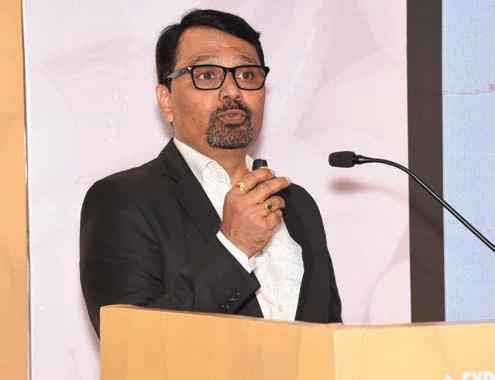
processes in the industry.
Giving an insight into what the future will hold, he informed the audience about certain evolutions such as: ◆ Proposals will move from price to product, based on the status of regulatory compliance
◆ Regulatory agencies will review submitted documents with the help of AI-based software
Management (MLCM) as it reduces analytical uncertainty, leads to improved method performance and decreases the cost of poor quality. He spoke on the importance of a structured approach to analytical development, the use of monographs, the evolution and implementation of lab informatics solutions and more in his presentation.
On approaches to ensure GLP, Sharma advocated the need for new-age solutions and skills. He gave some good examples of how these solutions can improve outcomes with better efficiency, reduce errors, lessen analytical uncertainties, address issues of poor
KEYTAKEAWAY
‘Analytical QualitybyDesign (AQbD) is an integral part of Method Lifecycle Management (MLCM) as it reduces analytical uncertainty,leads to improved method performance and decreases cost of poor quality’
quality and control costs.
He also gave an overview of Agilent and its solutions for analytical development and assured the industry that it can be a good partner in this sphere.
We need to incorporate predictive tools like AI, machine learning and data analytics and enhance the technical capabilities of individuals to overcome current regulatoryand compliance challenges in the pharma sector
agency
◆ Automation – PAT/continuous process/robot working ◆ 100 per cent testing at the point of manufacturing as against QC lab testing
◆
Harmonised regulations/ inspections across the world
◆
Shorter timeframes for regulatory approvals with specifically PAS ◆ Online surveillance of manufacturers by the regulatory
He had some good key takeaways and advice for the industry such as the future is digitalisation, adopt new changes positively, enhance technical capabilities, don’t lose any opportunity for improvement, be truthful, open and collaborative with the regulatory agencies and keep the patient at the centre of all actions.
January2023 EXPRESS PHARMA 29
Kuldeep Sharma,Sales Development
Manager (Pharma market), Agilent technologies
KEYTAKEAWAY
Kailash
Nale,Sr Director – QualityOperations,Cipla
Fostering innovation by responding quickly and effectively to the exponential changes happening in medicine, science and technology is a key challenge
Traceability,compliance & regulation: Three diamonds of pharma world
As the pharma sector continues its fight against counterfeiting and strategises to improve quality and compliance, the sector is in various phases of implementing and executing serialization and traceability solutions. As they continue along the learning curve, pharma companies are making traceability the cornerstone for future growth.
Anirudha Katekar, Director-Sales (India), Optel Group touched on these important aspects at Goa Pharma Summit 2022 and shared insights from his experience and expertise in automation, track and trace and supply chain traceability.

He began by sharing details
about his company and its offerings in this sphere. Katekar informed that the Optel Group
has over 30 years of experience in traceability solutions and has over 4,500 systems installed
worldwide. He updated that in December 2021, it acquired the pharma ‘track and trace’ unit of Körber, a company that leverages, empowers and captures data for supply chain digitisation to expand its presence in the European market.
He explained how Optel not only helps in enabling end-toend traceability and visibility but also aids regulatory compliance and quality. He also cited some interesting examples of the implementation of cutting-edge supply chain traceability platforms and solutions.
Emphasising the importance of patient-centricity in pharma, he said that traceability helps to optimise the efficacy of medicines and improve
Role of active packaging in drug development
Dhairy Sharma, Technical Sales, Cilicant, gave an insightful presentation on the role of active packaging in drug development at Goa Pharma Summit 2022. Elaborating on the crucial part played by packaging in drug development, he explained that active packaging is a smart packaging solution that is functionally active and helps to enhance the shelf life of a package system when used in a scientific manner.
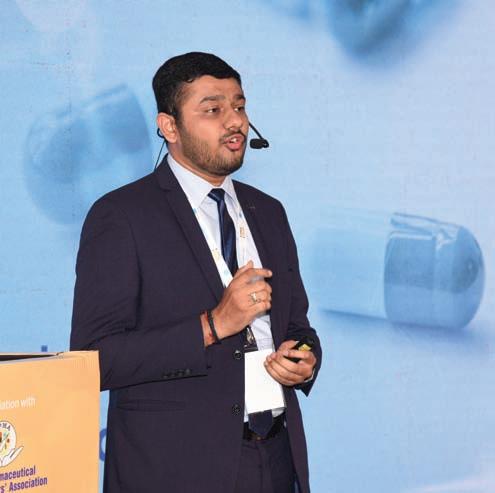
He also informed that in the case of active packaging, there are some key aspects such as volume of the bottle, oxygen transmission rate (OTR), moisture vapour transmission rate (MVTR), RH, temperature condition and the shelf life that needs to be taken under consideration. Sharma also explained the connection between moisture content and water and informed that moisture content is quantitative in nature and a driving force that
decides how one can choose the right packaging.
He gave an overview of the solutions offered by Cilicant for active packaging and elaborated on one of its offerings
called Accuflip. Giving more details about the solution, he said that it is an equilibrium relative humidity (ERH) regulator, it regulates the ERH to 20 ± 5 per cent RH within the
enclosed primary packaging, thereby preventing over- desiccation of capsule cells and
KEYTAKEAWAY
‘Traceability,compliance and regulation make the pharma industryunique and patient-centric with a broader vision to serve humanity.
health outcomes.
He also spoke on Optel's carton serialisation solution and explained how it works in detail. He concluded the presentation by saying that Optel is one of the most preferred partners for pharma companies in their traceability journey. He also invited all pharma professionals present at the Summit to visit Optel's facility in Goa.
KEYTAKEAWAY
‘Accuflip byCILICANTis an equilibrium relative humidityregulator which regulates the ERH within the specified range to protect the product.It is designed to be used in primarypackaging and prevents over-desiccation of the formulations’
protecting the product. He also explained how over-desiccation can adversely affect the efficiency and efficacy of pharma products.
Giving more details about Accuflip, he highlighted that it has a specialised sorbent which adsorbs and deabsorbs moisture at the same time. He elaborated on the relation between water activity and ERH and accentuated that active packaging should be used wisely to get optimal outcomes since the right solution at the right time is really important.
EXPRESS PHARMA January2023 30 POST EVENT
Mr Anirudha Katekar,Director-Sales (India),Optel Group
DhairySharma,Technical Sales,Cilicant
Active packaging is a smart packaging solution that is functionally active and helps to enhance the shelf life of a package system when used in a scientific manner
Polymer solutions for drug product manufacturing process
Sankalp Kokare, Assistant Manager (Business Development) at Ami Polymer gave a very detailed presentation on polymer solutions for the drug manufacturing process at Goa Pharma Summit 2022. He began by sharing vital information about different kinds of tubings and polymers, their features, advantages and applications in the life sciences industry. He explained how different drugs and dosage forms require different kinds of solutions that are suitable for different drug products such as silicone tubing for dedicated fluid flow systems, TPE tubings for tablet coating applications, imaliner tubing for preservatives resistance, FKM tubings for complex injections, FEP/ PTFE tubing for corrosive fluid transfer and polymer TC gaskets for corrosive chemicals. He also explained in


detail why these products are most suited for certain applications.
He shared a case study through which he established how SIP-compatible tubing is used for peristaltic pump ap-
plication and its impact.
Kokare also spoke at length about regulatory compliance on polymeric products and explained the factors that need consideration to achieve regulatory compliance.
Listing down various factors to be considered while
While choosing tubing solutions,keep in mind the method of sterilisation to be used byyou,validation package and sealing,welding capabilities etc’
choosing tubing solutions, Kokare said that the material of construction and components, class of the clean room, method of sterilisation used or to be used, absorption, adsorption and compatibility to products, extractables and leachables, validation package, regulatory standard tested, sealing, welding capabilities, pump pressure, etc are very crucial.
He ended the presentation by assuring the audience that Ami Polymer can help them with the right polymer solutions for their drug manufacturing process.
Building stronger qualitysystems for improved compliance
Yogeshsing Rajput, Executive Senior Manager, Indoco Remedies gave a very informative session on how quality management systems work and the advantages they bring to pharma processes. He updated on the effective use of SOPs and asked the industry to streamline and simplify their processes to make their quality management systems more effective.
In his presentation, he addressed several other key issues such as harmonising processes and procedures to improve efficiency, implementation of lean concepts, building and implementing peoplecentric systems, creating leaders at each level of the organisation, need for periodic review and revamp of the company's processes, creating a decentralised and
collaborative environment, etc.
KEYTAKEAWAY
QualityManagement System should reviewand refine the process,create meaningful objectives, harmonise procedure and should be simple to use
He spoke on the interlinking of CMA, CPP and CQA, and explained how that can improve quality processes. He also advised pharma professionals to be more transparent, look at the root cause of problems before implementing remedial actions and be growthoriented by being more open-minded to new technologies, ideas and approaches.
He concluded by saying that all lessons need to be reflected upon and implemented effectively to continuously enhance quality and compliance.
January2023 EXPRESS PHARMA 31 POST EVENT
KEYTAKEAWAY
Sankalp Kokare,Assistant Manager (Business Development) at Ami Polymer
Yogeshsing Rajput,Executive Senior Manager,Indoco Remedies
Kokare spoke about regulatory compliance on polymeric products and explained the factors that need consideration to achieve regulatory compliance Look at root cause of problems before implementing remedial actions and be more open-minded to new technologies, ideas and approaches



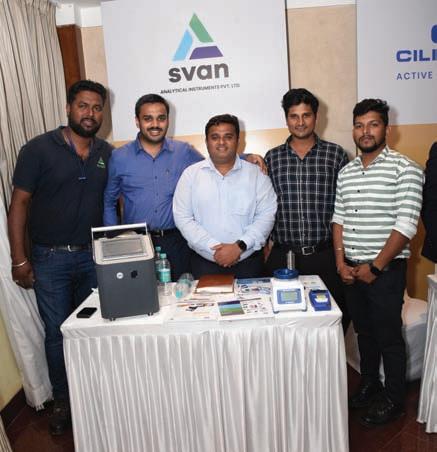

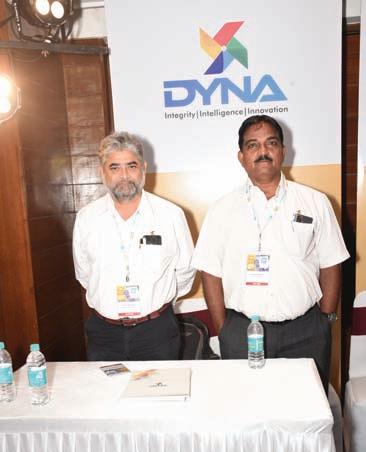
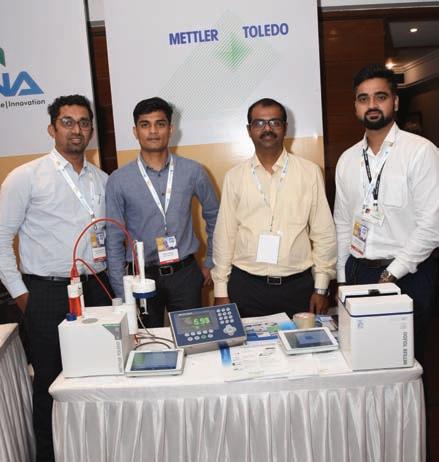
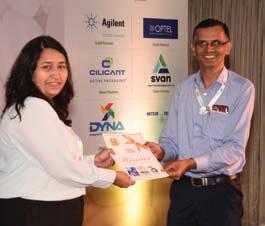


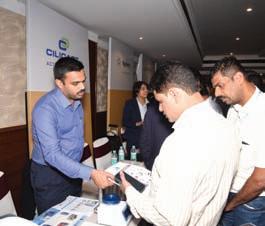

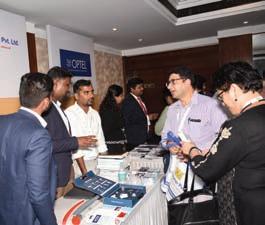
EXPRESS PHARMA January2023 32 POST EVENT GLIMPSES OFGOAPHARMASUMMIT2022








OPINION
Digital,Data and Dialogue: The 3D approach to enhance clinical trials in 2023

2023, the year of equilibrium, is upon us. Most people, processes and industries have oscillated between extremes since the pandemic began. Now is the right time to plan, achieve and sustain balance with a medium- to long-term outlook. Take clinical trials, for instance, which are on the cusp of becoming truly global, accessible and equitable.
Case in point: India is home to approximately 18 per cent of the world’s population. However, we form a meagre two per cent of the global clinical trial population. While many similar examples confirm the gaps and latent opportunities, the pandemic did bring a silver lining for the clinical trials industry.
Successfully completing the COVID-19 vaccine trials from start to finish in one year as compared to the typical seven10-year timeframe was an unimaginable feat, particularly for healthcare workers who had the dual responsibility of caring for patients while trying to drive research and getting an accurate understanding about the new disease. The 3D approach of Digital, Data and Dialogue is aligned with emerging trends we are observing as we partner and engage with patients, sponsors, investigators and CROs globally.
CIOs’ evolving role and new digital transformation enablers: The new year will see a stronger coupling between clinical operations leaders and CIOs and digital transformation teams, resulting in greater
collaboration and innovation in the next few years.
We are already seeing the benefits of this cross-functional amalgamation, particularly in the way digital (and data) can be leveraged to drive efficiency at a portfolio level, instead of the traditional trialby-trial approach.
One of the best examples is through setting up a centralised control tower. Akin to an air traffic controller that captures information from varied sources, a control tower for a clinical trial can be set up to ingest data from multiple sources and stakeholders such as trial sites, patients, wearable devices, ePRO (PatientReported Outcomes), Electronic Data Capture (EDC), Electronic Medical Record (EMR), CRO, logistics and patient recruitment; with the similar final objective of ensuring safe, smooth and timely operations.
A UK-headquartered large pharma company piloted this concept during the early onset of the pandemic. The fact that they have done a comprehensive roll-out within two years of that pilot is testimony to the success of such a model.
Establishing and leveraging unified data lakes and cloud infrastructure are strong enablers for a clinical control tower, and both initiatives are typically led by the CIO. However, transforming such a control tower – from a monitoring station to an action centre –takes the outcomes and Return On Investment (ROI) to a different pedestal by reducing the lag between insights and
actions through automation.
Another initiative that aims to establish a future state of automated and dynamic readiness is underway as an industry-wide consortium at Transcelerate. Sharing and learning with other partners of this initiative has provided us a lot of promise regarding the future of drug development. Diverse and enhanced usage of real-world data: Information silos need to be broken to leverage data and digital to our advantage. In many developed countries, anonymised insurance claims and laboratory data are commercially available for analysis. These help improve trial design, patient recruitment and operations. However, access to granular data is limited in the rest of the world. While efforts are being made to curate real-world datasets for oncology, rare diseases and other therapies, this remains one of the biggest challenges and opportunities.
Once data silos are broken, it becomes easier and more effective to deploy last-mile applications such as telemedicine for virtual trial participation, digital outreach to patients to
enroll them into relevant trials, online consent for trial participation (similar to virtual KYC that many in India have experienced backed by Aadhaar infrastructure), and so on. Another key advantage of deploying the combination of data and digital is to enable a fool-proof and audit-ready trail. Real-time (or near realtime) digitisation of data is one of the simplest and most important levers that can uphold the authenticity, transparency and credibility of a clinical trial.
FDA and other regulators globally have been increasingly releasing guidance to leverage real-world data for clinical trials (the latest one was in September 2022). Finding the equilibrium between realworld and trial data is going to be one of the most interesting aspects we need to keep an eye on.
Dialogues with patients: Any innovation in healthcare is incomplete without thinking about the human element, change agents and behavioural aspects.
For example, leveraging digital and social media as a patient-recruitment strategy is now table stakes. However, the manner in which one should exchange information to positively impact the psychology of patients and caregivers will remain a critical success factor. With ever-increasing scrutiny on major social media platforms ensuring a humane, empathetic, compliant yet result-oriented communication based on researchbased evidence is the way
forward to cut through the information overload we all are exposed to.
The farther the distance between a care provider and a patient, the greater the deterrent towards mindful and willing trial participation across countries, and racial and ethnic groups. There are many best practices that site teams and investigators can deploy at the grass-roots level, such as leveraging WhatsApp broadcast to share non-confidential awareness information (while ensuring the right privacy and data security checks and balances are in place), scheduling dedicated timeslots to see trial patients and their caregivers and leveraging compliant vernacular content to facilitate two-way communication.
Facilitating these dialogues at scale requires agility and the ability to track and manage multiple swimlanes between R&D and commercial insights for sponsors, regulators and other stakeholders. Listening to experiences, feedback and perceptions of patients, caregivers, sites, patient advocacy groups, non-profit foundations and other stakeholders is vital –so, they don’t see themselves as tools or subjects, but rather true partners in driving success together.
Much has been talked about decentralised trials. It is safe to say that hybrid trials are here to stay. It’s time for the broader healthcare ecosystem and the clinical trial fraternity, in particular, to rally together and adopt the 3D (Data, Digital, Dialogue) mindset to move the industry forward.
EXPRESS PHARMA January2023 34
RESEARCH
Deepak
Gandotra,Senior Director,Enterprise Clinical Solutions,Indegene,believes the new year will see a stronger coupling between clinical operations leaders and CIOs and digital transformation teams,resulting in greater collaboration and innovation in the next few years
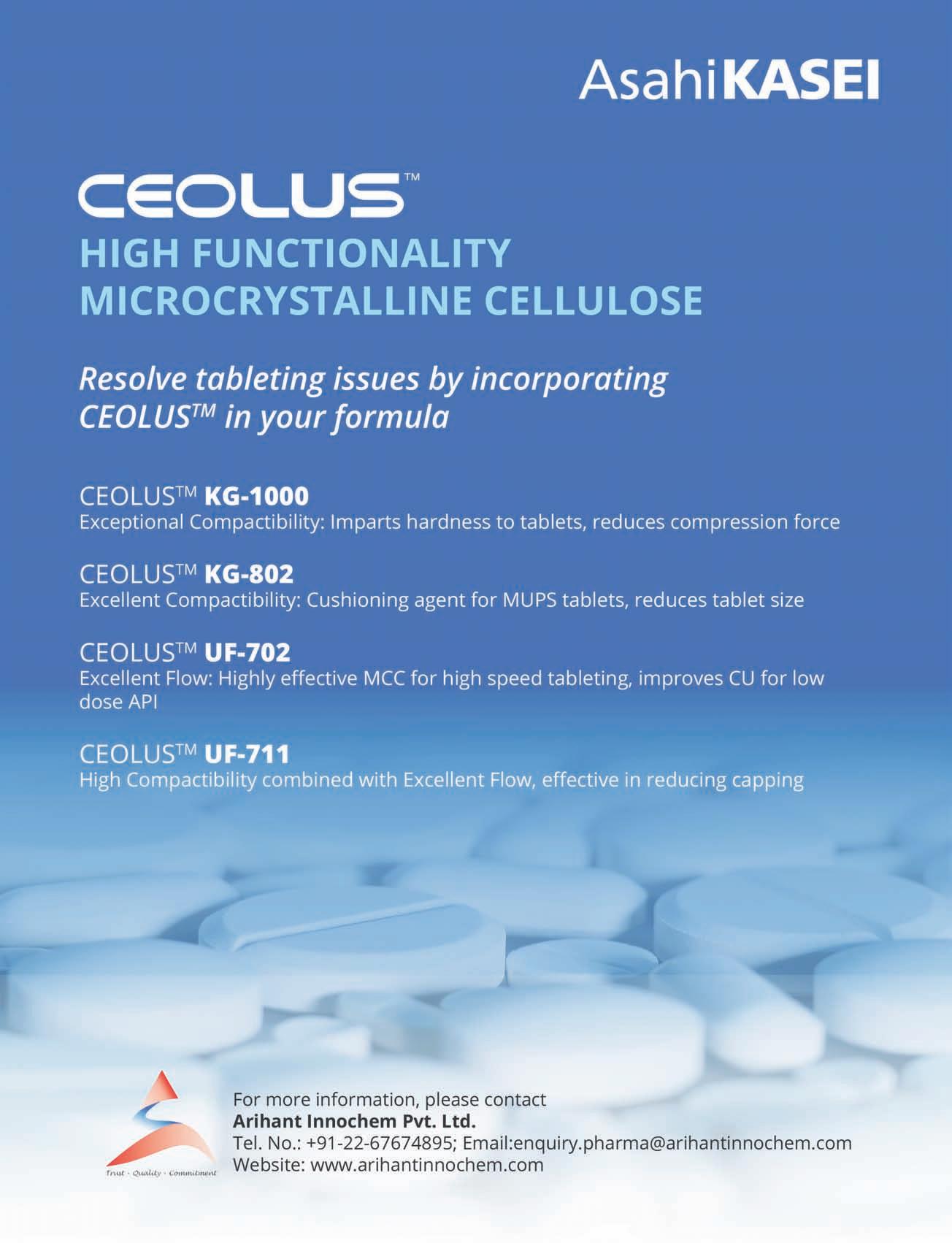
BUSINESS AVENUES EXPRESS PHARMA EXPRESSPHARMA January2023 35
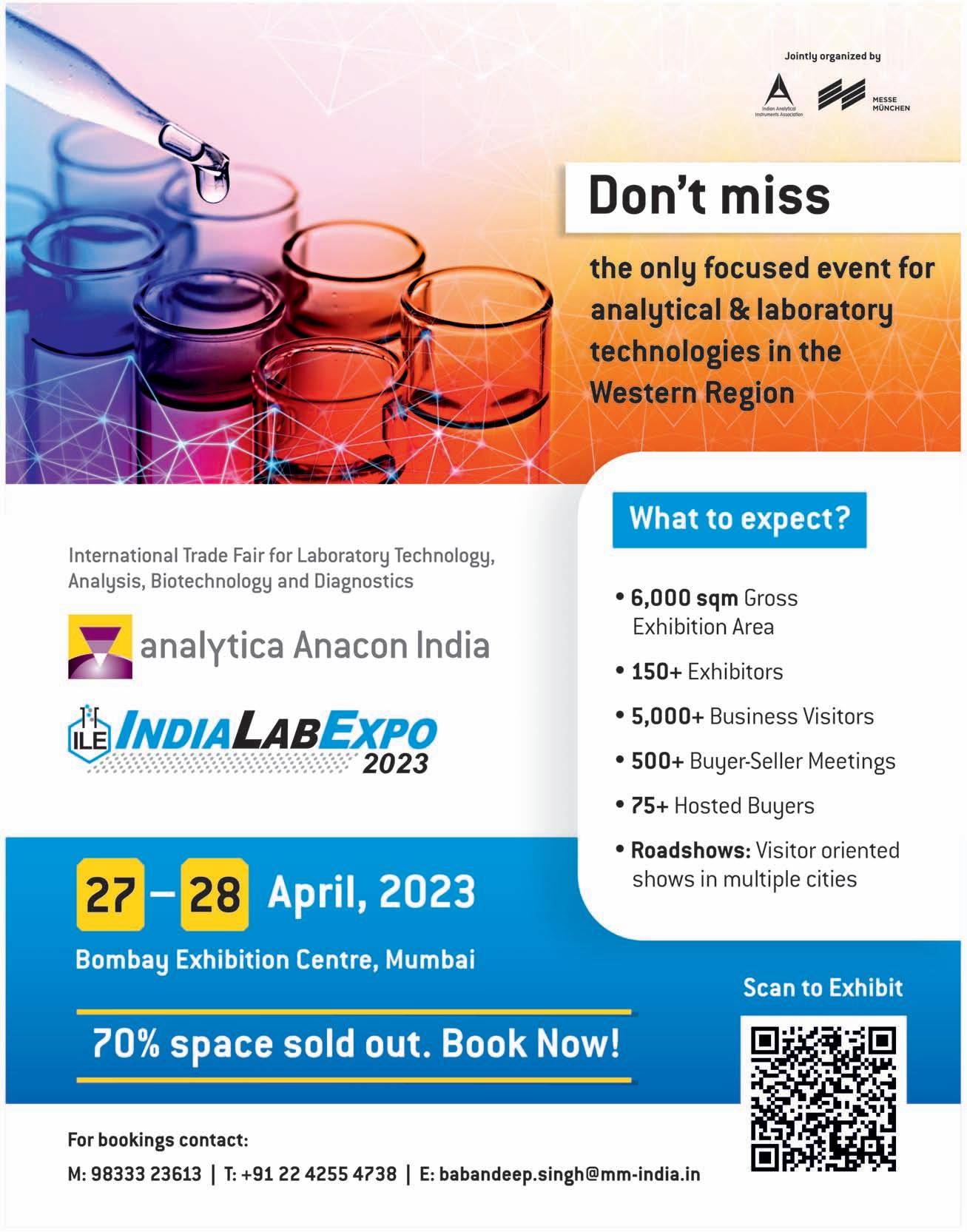
BUSINESS AVENUES EXPRESS PHARMA January2023 EXPRESSPHARMA 36

BUSINESS AVENUES EXPRESS PHARMA EXPRESSPHARMA January2023 37

BUSINESS AVENUES EXPRESS PHARMA January2023 EXPRESSPHARMA 38

BUSINESS AVENUES EXPRESS PHARMA EXPRESSPHARMA January2023 39
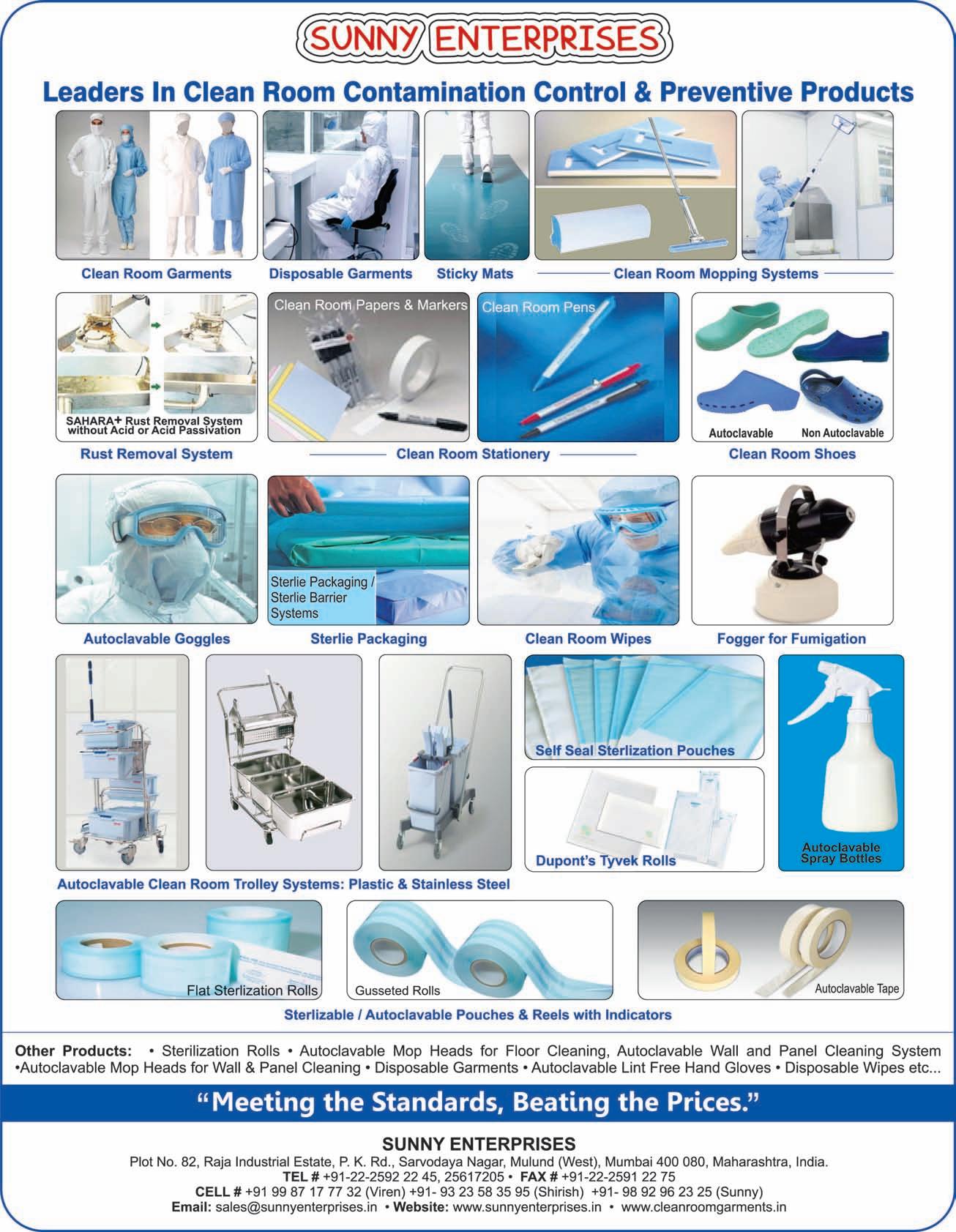
BUSINESS AVENUES EXPRESS PHARMA January2023 EXPRESSPHARMA 40


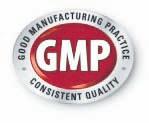
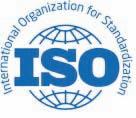
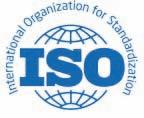







BUSINESS AVENUES EXPRESS PHARMA EXPRESSPHARMA January2023 41
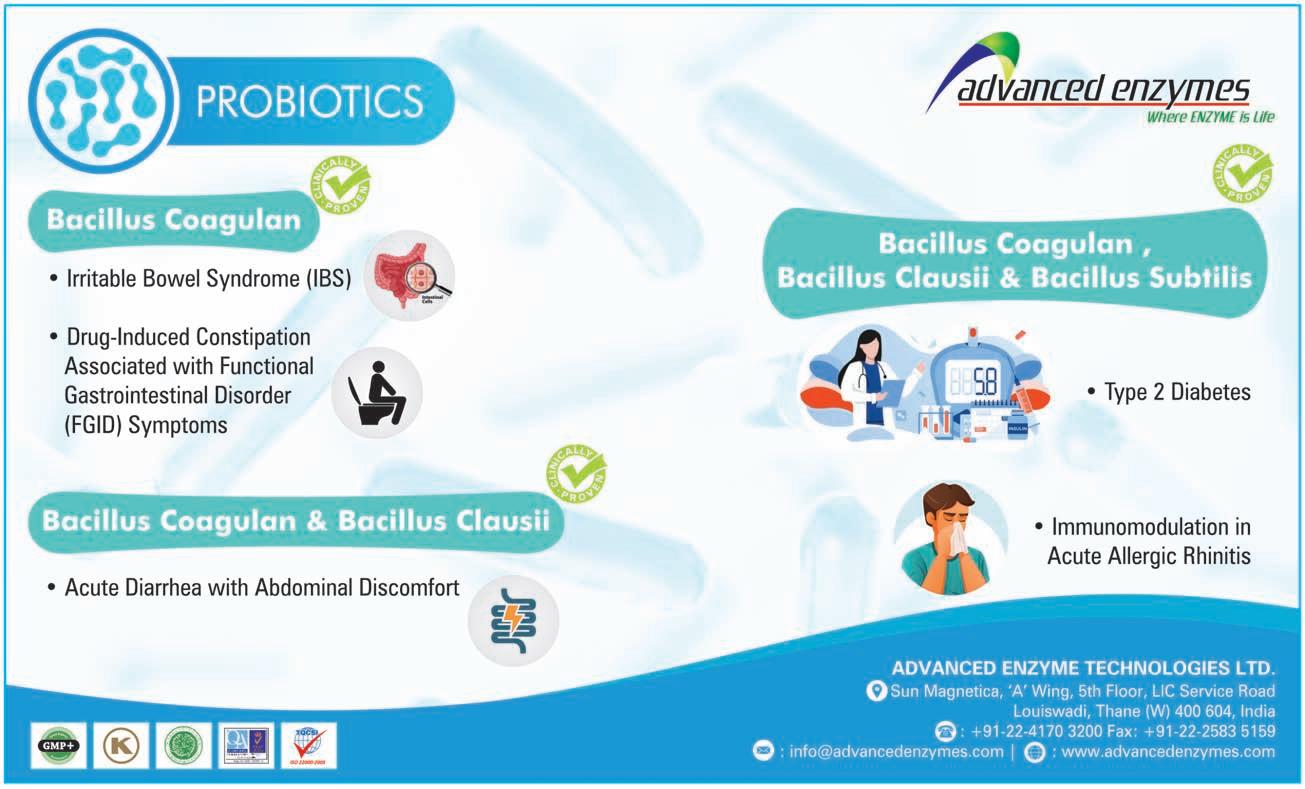
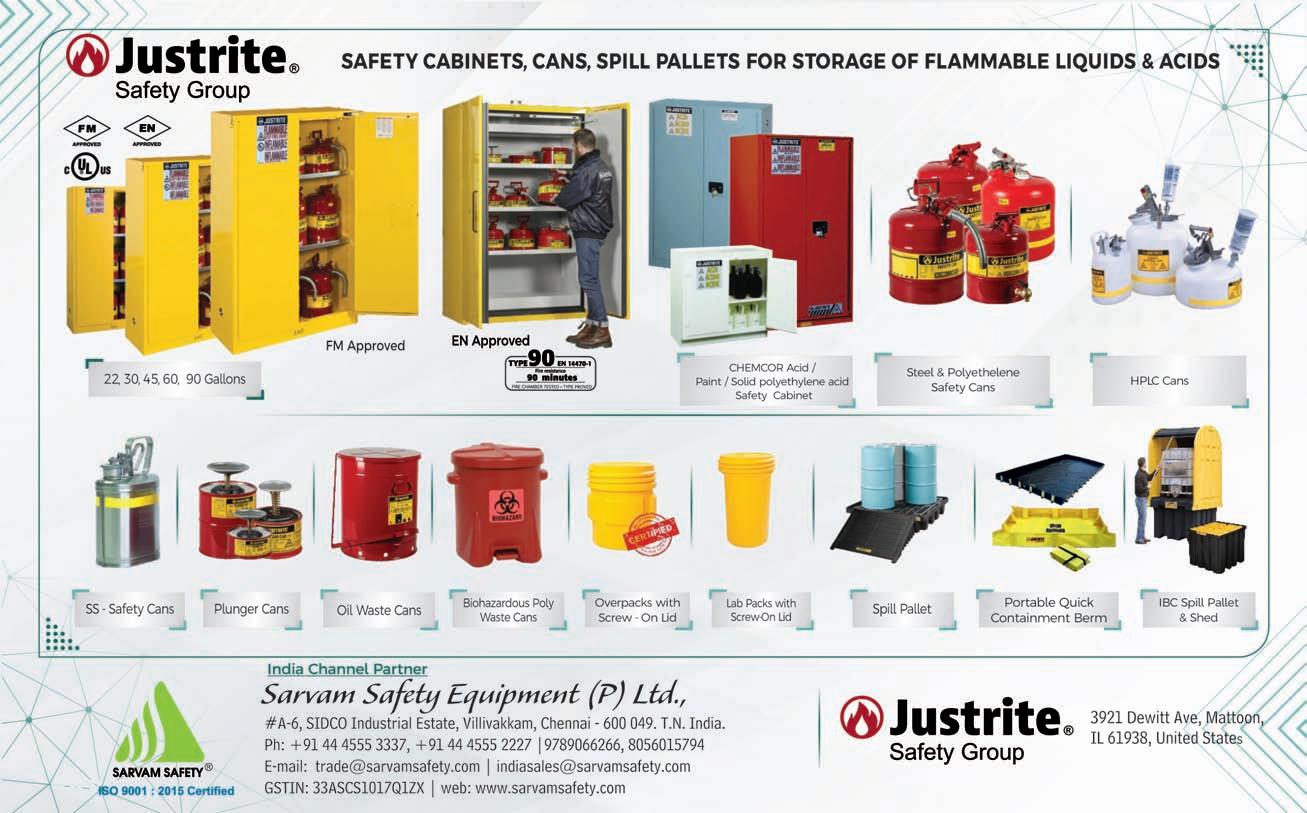
BUSINESS AVENUES EXPRESS PHARMA January2023 EXPRESSPHARMA 42

BUSINESS AVENUES EXPRESS PHARMA EXPRESSPHARMA January2023 43













BlueHeaven SILICONETRANSPARENTTUBING M.K.SiliconeProductsPvt.Ltd. E-mail:sales@mksilicone.com 205&206HillViewIndustrialPremises,AmrutNagar, Ghatkopar(W),Mumbai-400086,India.Tel.:022-25004576 fortheQualityConscious…. INDIA QM002 AnISO9001-2015COMPANY Quality Products Since 1997 CERTIFIED CLEA N ROOM IS08 ® ® ® BUSINESS AVENUES EXPRESS PHARMA January2023 EXPRESSPHARMA 44
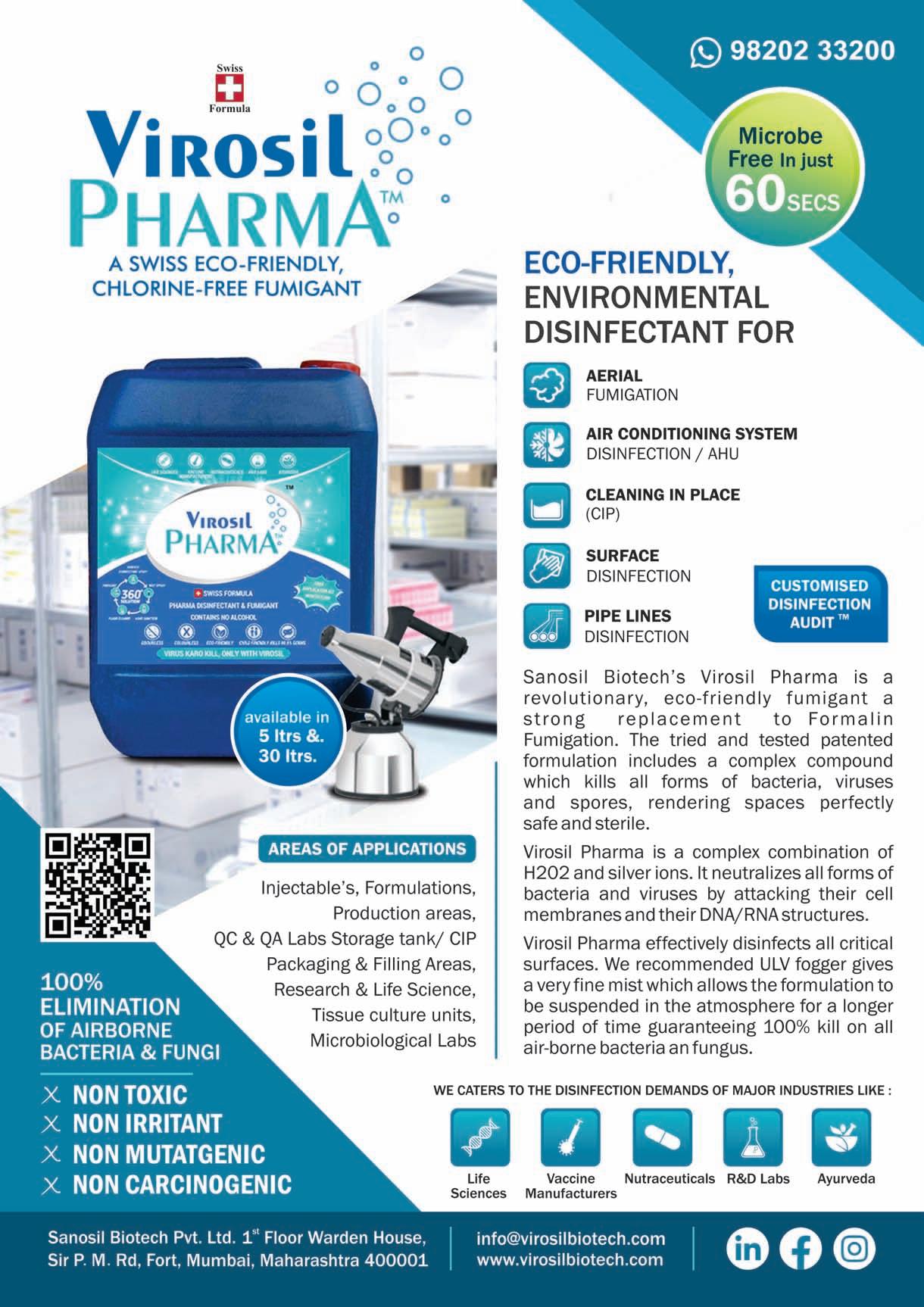
BUSINESS AVENUES EXPRESS PHARMA EXPRESSPHARMA January2023 45

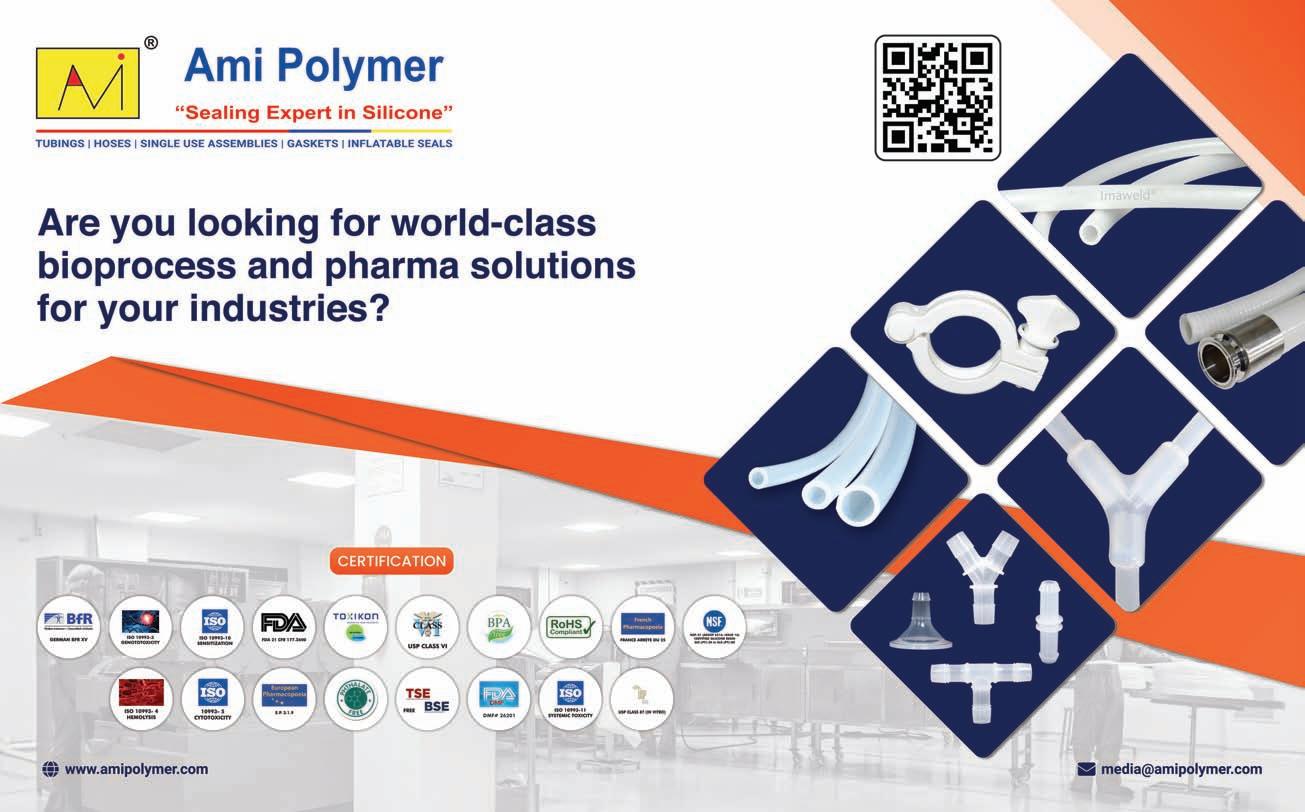
BUSINESS AVENUES EXPRESS PHARMA January2023 EXPRESSPHARMA 46
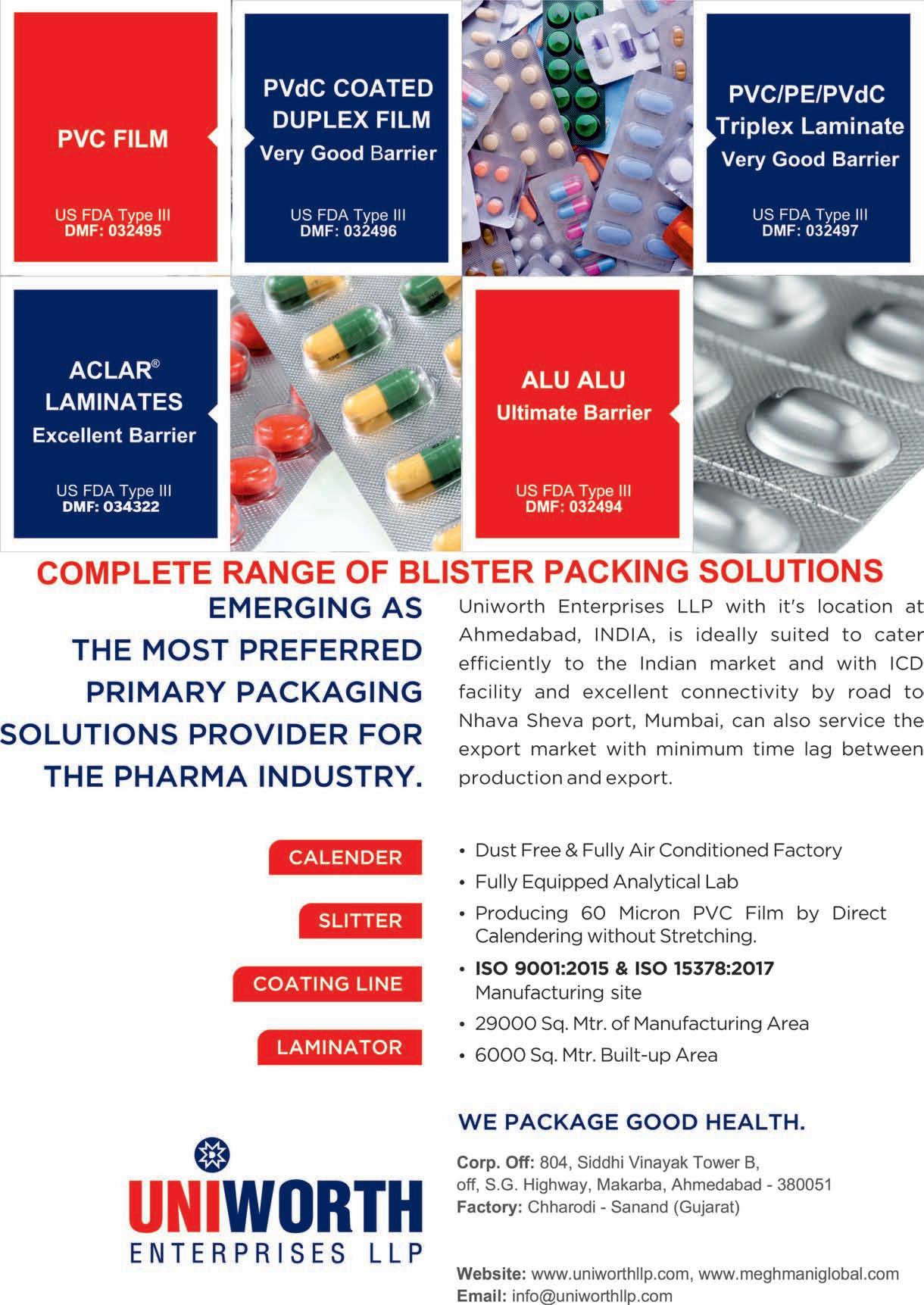
BUSINESS AVENUES EXPRESS PHARMA EXPRESSPHARMA January2023 47

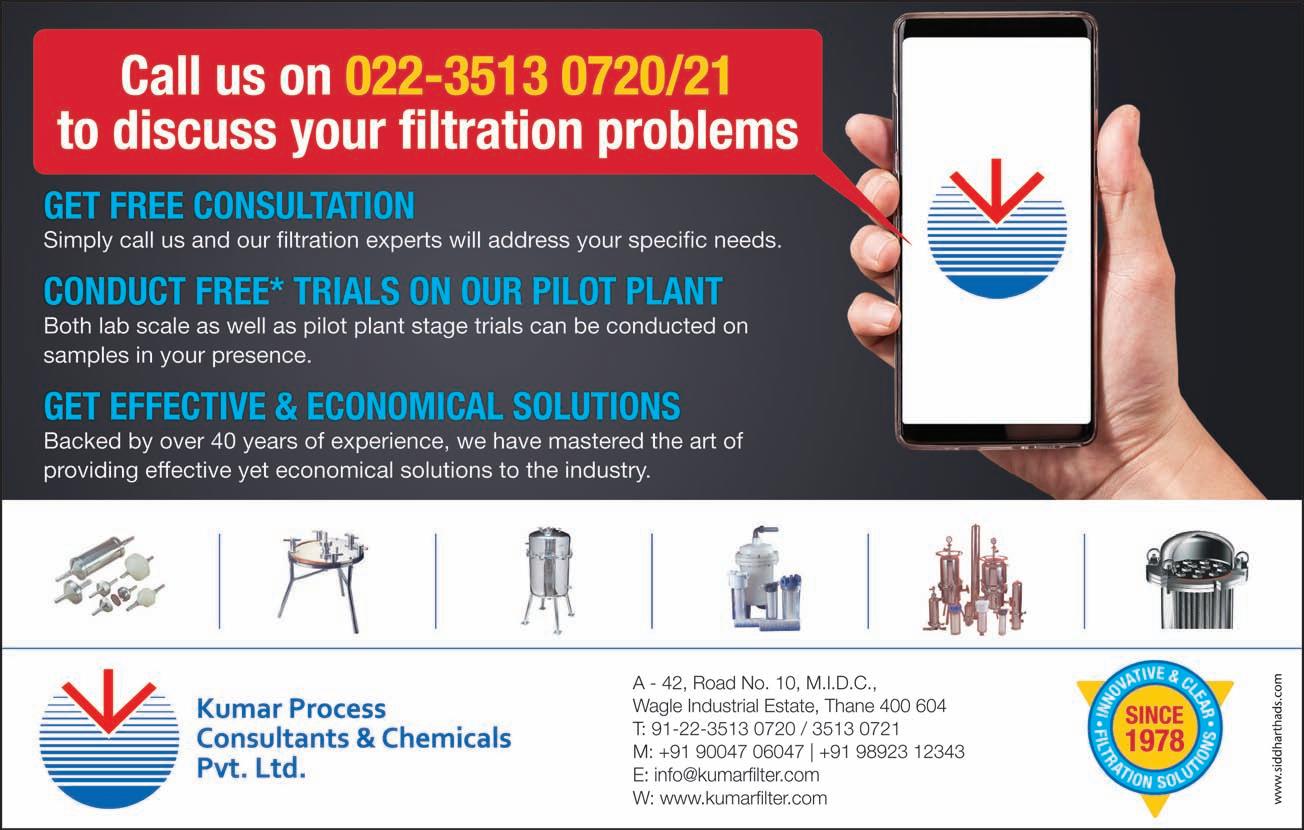
BUSINESS AVENUES EXPRESS PHARMA January2023 EXPRESSPHARMA 48

BUSINESS AVENUES EXPRESS PHARMA EXPRESSPHARMA January2023 49











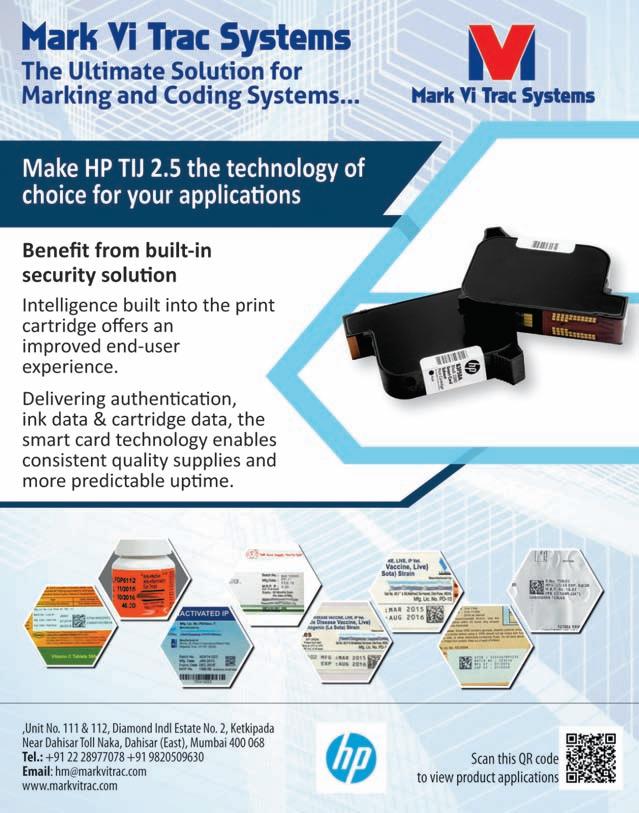

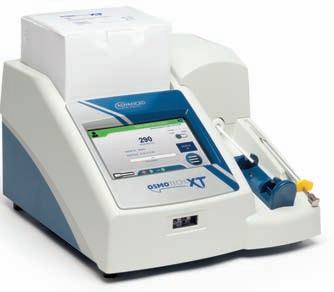

OsmoTECH®XTSingle -SampleMicro-Osmometer Best-in-classosmolalityperformance, designedwithyouinmind. Nowavailable! HIGHLIGHTEDFEATURES: No.127,BussaUdyogBhavan,TokershiJivrajRoad,SewriWest,Mumbai-400015, Maharashtra,Landline:+91022-24166630Mobile:+919833286615 Offersthewidestrangeofosmolalitytesting(0–4000mOsm/kgH2O) Supports21CFRpart11,GMPandEUAnnex11compliance MeetsPharmacopeiaosmolalitytestingguidelines 3Leveluseraccessandpasswordprotection Storage:unlimiteddatastorageforaccess Audittrail:Preserveunlimitedresultsandevents Databasebackup,protectsyourdatawithautomaticormanualbackup BUSINESS AVENUES EXPRESS PHARMA January2023 EXPRESSPHARMA 50
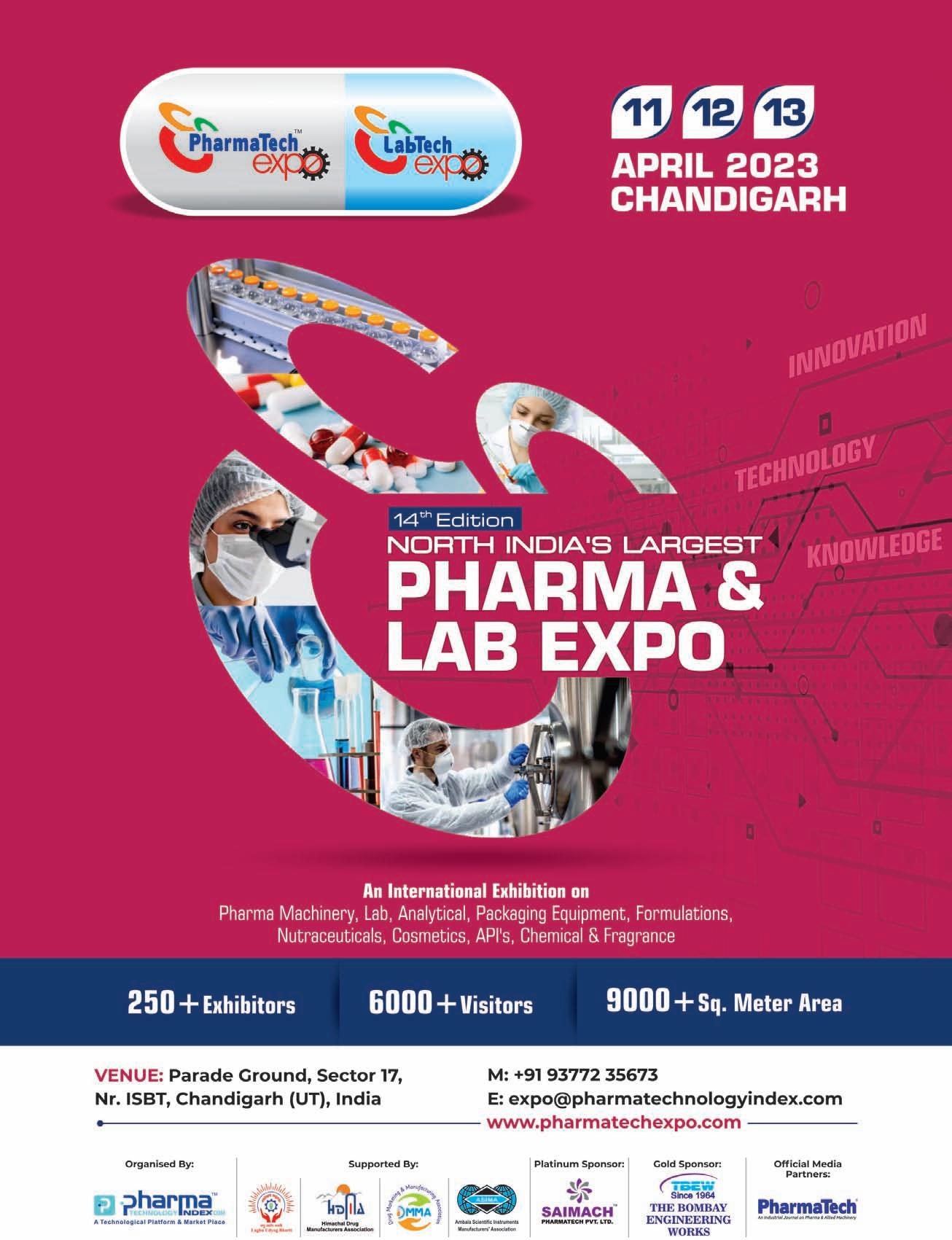
BUSINESS AVENUES EXPRESS PHARMA EXPRESSPHARMA January2023 51
PHARMA PULSE
Simplifying pharma – Laboratorydigital transformation
Finnan,Marketing Intelligence and Strategy Specialist,Yokogawa Corporation of America,

As pharma manufacturers pursue digital transformations, management realises many opportunities for improvement in laboratory information management and workflow processes.
Using traditional methodologies in which large quantities of data are transcribed, technicians find the raw data transcription subject to errors. Even the checking process introduces the risk of errors. Review processes are often cumbersome. It takes considerable time to check dilution calculations, blank calculations and reported values. Analysing and tracing historical data, exceptionally when test records are maintained as paper documents, also incur considerable time. There are inefficiencies in report generation. Sometimes, there is a lack of space for storing test records as paper documents.
Older methodologies also make compliance with the US Food and Drug Administration (FDA) 21 CFR Part 11 and other regulations more complex. Non-digital methods are prone to inconsistencies in recordkeeping, which could complicate audits.
Non-digital methods further introduce difficulties when personnel outside the lab need to check on testing progress. Internally, the manufacturing and shipping departments most often need access to this information. It also takes considerable time to prepare high-quality details to respond to the requests of external parties such as customers.
Digital transformation programme teams are most commonly challenged with:
◆ improving the efficiency of data collection and analysis
◆ improving the efficiency of quality control management
◆ improving overall business efficiency
◆ overcoming problems with human errors and document
management
Digitalising the lab
Manufacturers who are digitalising laboratory information management and workflow processes can realise numerous benefits. It is desirable to unify the data management, including managing requests to external analytical laboratories. In a transformed operation, the unified information can be made available throughout the enterprise and the supply chain— and provided in formats best suited to all individuals requiring access.
In addition, unified management of analysis data and analysis workflows meets customers' requirements for enhanced quality management and enables them to respond to recalls and complaints quickly.
The lab needs an ecosystem that fully supports analytical and quality management operations to transform laboratory data management and workflow processes. It allows end users to establish test workflows to standardise and optimise laboratory operations.

Ultimately, this system's core is to minimise human error, improve laboratory information management workflows, increase quality control reliability, and ensure compliance with such regulations as FDA 21 CFR Part 11.
Some specialised technologies provide compliance with pharma industry guidelines and regulations; they can also be deployed in the analytical laboratories in other industries such as Food and Beverage (F&B) and chemical processing, where all raw materials, intermediates and products are subject to analysis and quality management.
Tight integration with Enterprise Resource Planning (ERP) platforms and Manufacturing Execution Systems (MES) improve the overall operational efficiency across the enterprise.
By automating formerly manual processes, the technology helps in increasing efficiency, and greatly reduces the risk of errors. Automated calculation of reported values from raw data reduces processing time. It could also eliminate a calculation process check and remove human errors, improving efficiency. Automated collection of measurement results from analysers eliminates the need for raw data transcription. Dilution, blank other calculations and rounding reported values are automated. The enhanced security functions can prevent data manipulation, and a data change history can also be recorded.
Automated lot-by-lot recording of test information such as the equipment in use and reagent or technician name facilitates traceability and data analysis. The platform manages the progress of each lot and enables the test progress to be viewed graphically from the manufacturing and shipping terminals.
Conclusion
To enable the digitalisation of pharma operations from the laboratory through the enterprise, the new system offers numerous benefits as follows:
Standardisation of quality control operations – Users can establish standard workflows to improve the quality and efficiency of analytical processes.
Workflow reductions through lab automation – The platform allows technicians to connect online with various analytical instruments and automatically collect analytical data. This has a significant labour-saving impact on data input and prevents transcription errors and data falsification.
Regulatory compliance through security and traceability features – Operators achieve secure system operations by granting appropriate permissions to users through user ID and password at login and authorisation. Further, as a traceability function, users can check the history of sample acceptance, approval of results and release evaluation.
Paperless operations and improved search speed - Online input of test data eliminate hardcopy, and test data can be approved and released via an electronic signature. In addition, a database that includes test data and approval data allows searching at a much higher speed than paper-based
data management would allow. Quickly comparing and analysing past data allows management real-time test data management decisions.
Accommodation of a wide variety of forms – The platform allows users to create form layouts freely. This can significantly reduce the engineering costs required for form creation.
Stability test plan preparation – A stability test can be planned to evaluate the ageing deterioration of drugs. Automated test requests are sent in accordance with the plan. This can prevent missed testing time points and analytical method errors.
Concurrent validation and retrospective validation improve data reliability - The past and present test data can be referenced by the test unit. Users can also set permissions for editing test data and viewing the audit trail of any alteration.
A wide variety of both intangible and quantifiable benefits – Among the former are eliminating human error in data entry, transfer and calculations, and increased efficiency in analytical and experimental tasks via standardisation. High data traceability improves customer satisfaction, and improvements in product quality and compliance operations lead to increased reliability in company-wide quality management.
Quantifiable benefits include the automatic input of experimental data, a reduced workload for double-checking and a reduced workload for instructions, records and reports. Barcode scanning reduces the workload in reagent and analyser management. The new technology enables integration with many other business systems and substantially increases data traceability and audit preparation efficiencies.
Kevin Finnan kevin.finnan@yokogawa.com
EXPRESS PHARMA January2023 52
elucidates how laboratories can be transformed
Kevin
digitally to simplify the pharma sector The industryis digitalising the pharma lab
Technical seminar organized bySignet in collaboration with
Shin-Etsu,India 2022
Signet, the leading distributor of pharma excipients in India is associated with 23 leading excipient manufacturers from the USA, Europe & Japan offering over 450 various excipients for almost every application and dosage form.
Along with its principal partner Shin-Etsu, a global leader in cellulose-based polymers, Signet organized technical seminars in Ahmedabad and Hyderabad on 16th and 18th of November 2022 respectively. Both the venues received an overwhelming response with over 200 attendees for both the locations from various pharmaceutical companies. The objective of these seminars was to highlight the applications possible with Shin-Etsu excipients along with emphasis on certain novel technologies for solubility enhancement. Six eminent speakers shared their expertise on various topics.

Mr. Nitin Bhusane, Director at Shin-Etsu, India presented chemistry and applications of cellulosic polymers majorly focusing on its use in HME for solid dispersion and further processing into final dosage form. The presentation also covered a brief introduction on other approaches to formulate a solid dispersion along with case studies conducted by Shin-Etsu lab on Nifedipine and Itraconazole by HME.
Dr. Padma Devarajan, Dean at Institute of Chemical Technology (Former UDCT), Mumbai delivered a lecture on advanced third generation solid dispersion. The case study on bioavailability enhancement of curcumin brilliantly displayed a novel concept of application of solid dispersion as a coating membrane on neutral substrate.
Dr. Ajmeera Ramkishan, Deputy Drug Controller of India precisely covered the regulations and norms on drugs and excipients specifically for
the Indian market.
Mr. Manoj Bansal, Commercial Leader - MC India, Thermo Fischer, delivered an excellent lecture on the basics of holt melt extruder. He meticulously covered the anatomy of HME and its accessories, a systematic approach towards development and
optimization of formulation, basic engineering principles used in HME and its significance in scale up processes.
Mr. Nilesh Mahajan, Technical Manager at Shin-Etsu, India presented on continuous manufacturing by twin-screw granulation process using Shin-Etsu excipients. He also
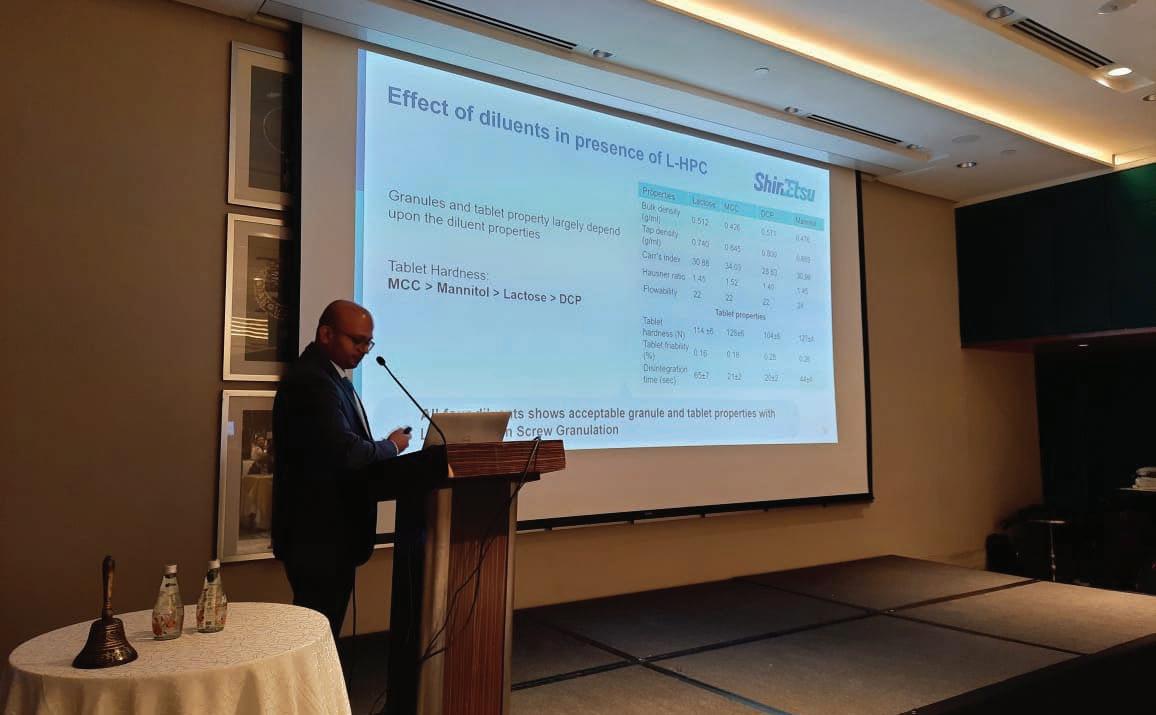
covered solvent based approaches for preparing solid dispersion.
Mr. Arun D’Souza, Technical Manager at Shin-Etsu, India comprehensively covered the application of Shin-Etsu polymers in enteric coating application via aqueous, non-aqueous and ammonia
neutralization approaches. He also presented case studies of application of Metolose grades for sustained release formulations.
All the sessions were very informative and addressed the possibilities of evaluating ShinEtsu excipients for various applications.
January2023 EXPRESS PHARMA 53
AI-enhanced machine vision
Machine vision algorithms based on deep learning are opening up exciting new ways to improve quality, boost productivity and p revent waste while making manufacturing more flexible. "Our collaboration with MVTec gives machine builders access to the best selection of the best performing vision functions around. They're an industry leader in both deep learning and classic rule-based algorithms - two complemental approaches that each play an essential role in machine automation" says Andreas Waldl, Machine Vision Expert, B&R.
Speed reader
The first product to emerge from the project is a deeplearning-based Optical Character Recognition (OCR) function. Called deep OCR, it achieves remarkably fast read rates, even on fonts that are otherwise difficult to recognise. "For many years, we have been working together with B&R to develop machine vision solutions for customers that set technological standards, especially for embedded systems. This goal is also being followed by our latest cooperation. As a result, customers benefit from the advantages of the deep learning technology Deep OCR without having to sacrifice performance," says Thomas Hopfner, Product Manager, Licensing and Interfaces, MVTec.
TOPS-per-watt winner
High-performance deep learning algorithms require a powerful processor. Yet, implementation as an edge device also made power consumption a critical issue. Today's machine builders need not just computing speed, but also power efficiency, and that is where Hailo comes in. In addition to world-class performance of
B&R is enhancing its smart camera portfolio with powerful deep learning functionality.A three-way collaboration with machine vision software specialist MVTec and AI processor specialist Hailo makes the B&R camera a powerful and efficient edge device.At the SPS trade show in Nuremberg,the companies celebrated the first function to come from their joint project
26 Tera-Operations Per Second (TOPS), the company's inference accelerators also require remarkably low power consumption. "Hailo helps us put truly groundbreaking speed and intelligence right where our customers need it for their fastest and most adaptive manufacturing solutions," says Waldl.
"This kind of collaboration is exactly what we had in mind when we started Hailo," says Orr Danon, CEO, Hailo. "The new B&R camera harnesses Hailo's top-performing AI
accelerator, and, in combination with their state-of-the-art edge devices and MVTec's advanced machine learning algorithms, we are setting new performance standards that will improve productivity and enhance quality in industrial applications."
machine vision. MVTec products are used in all demanding areas of imaging: semiconductor industry, surface inspection, automatic optical inspection systems, quality control, metrology, as well as medicine and surveillance. By providing modern technologies such as 3D vision, deep learning, and embedded vision, software by MVTec also enables new automation solutions for the Industrial Internet of Things aka Industry 4.0. With locations in Germany, the USA, and China, as well as an established network of international distributors, MVTec is represented in more than 35 countries worldwide.
processor is designed to fit into a multitude of smart machines and devices, impacting a variety of sec-tors including security, automotive, Industry 4.0, and retail.?For more information visit https://hailo.ai/
About B&R
About MVTec
MVTec is a leading manufacturer of standard software for

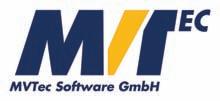
About Hailo
Hailo, an AI-focused, Israelbased chipmaker, has developed a specialized AI processor that delivers the performance of a data center-class computer to edge devices. Hailo's processor is the product of a rethinking of traditional computer architecture, enabling smart devices to perform sophisticated deep learning tasks such as object detection and seg-mentation in real-time, with minimal power consumption, size, and cost. The
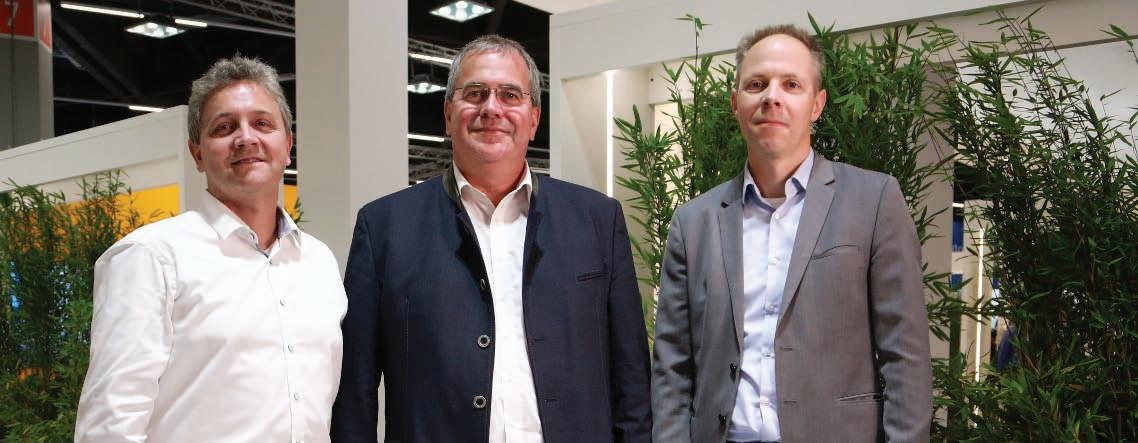
B&R is an innovative automation company with headquarters in Austria and offices all around the world. On July 6, 2017, B&R became a business unit of the ABB Group. As a global leader in industrial automation, B&R combines stateof-the-art technology with advanced engineering to provide customers in virtually every industry with complete solutions for machine and factory automation, motion control, HMI and integrated safety technology. With Industrial IoT communication standards like OPC UA, POWERLINK and openSAFETY as well as the powerful Automation Studio software development environment, B&R is constantly redefining the future of automation engineering. The innovative spirit that keeps B&R at the forefront of industrial automation is driven by a commitment to simplifying processes and exceeding customer expectations.
For more information, visit www.br-automation.com
EXPRESS PHARMA January2023 54 PHARMA PULSE
Deep learning for B&R cameras with MVTec and Hailo
Deep learning for machine vision: B&R,MVTec and Hailo celebrate successful collaboration at SPS 2022
Exploring biological buffers and their uses in pharma industry
Christoph Zahner,Senior Manager,Global Business Development,Biopharmaceuticals,DKSH,

explains about the role of buffers in biological experiments
Biological buffers play an essential role in a wide range of applications used in biopharma manufacturing processes.

The characteristics of biological buffers, the adjustment of the pH value and the stabilisation of the biological systems are essential when performing biological experiments because proteins and enzymes are sensitive to changes, therefore, biological buffers are vital to maintain a healthy biological system and ensure consistent results in the experiment or during the manufacturing process.
We examine the importance of biological buffers and the process of choosing the correct buffer for current upstream and downstream experiments.
Essential properties of biological buffers
In the past, different inorganic substances, such as phosphate, cacodylate, borate, and bicarbonate, were used as buffers, with organic acids added to the list to conduct bi-
ological experiments. However, the disadvantage of these buffers was that they were not inert, because these substances were enzyme substrates or enzyme inhibitors and could react with metabolites or other components. For a buffer to be effective, it should not be subject to either enzymatic or non-enzymatic changes, and, therefore, be inert.
The right buffering system can protect the integrity of biomolecules and reagents and provide solution stability and pH control without inter-
fering with biological processes. Buffer systems also need to supply critical salts and nutrients for cells and tissues to thrive. The right system can bring stability to cell culture, Polymerase Chain Reaction (PCR), drug screening, bioprocessing, purification and final formulation applications.
Essential properties of an effective buffer: ◆ Solubility ◆ Permeability through biological membranes is an important requirement ◆ pKa value at the mid-point
of the range of the test system ◆ Change in pKa value should be dependent on temperature ◆ Change in pKa value should also be dependent on dilution ◆ Interaction with other components (e.g. metal ions, enzymes) ◆ UV absorption ◆ Non-toxic
Choosing the right buffer
When choosing a buffer, while considering its advantages and disadvantages, it is important to ensure that the pH range of the agents you plan to use in an experiment coincides with the pH range of your chosen buffer. Another consideration is that the pKa value should be within one unit of your desired pH.
The other elements to focus on are concentration, buffer toxicity, temperature and reactivity: Concentration: The concentration of your buffer must be sufficient to account for the amount of acid or base you plan to use in your experiment. The more the pH-altering component you plan to use,
the higher the buffer concentration you will need.
Buffer toxicity: Buffer toxicity is highly important because some buffers can be toxic to the cells you are working with. If unsure about the toxicity, you can test the buffer on the cells before using it in the experiment.


Temperature: As the temperature can alter the buffering capacity of your buffer, checking the temperature for your experiment is essential.
Reactivity: Finally, ensuring that your chosen buffer does not produce unwanted reactions in your experiment is important to conduct a reactivity test.
At DKSH, our international team of technical specialists collaborates across borders to develop innovative solutions to enhance your pharma innovations and formulations. Contact to learn more.
Sources:
Gold Biotechnology: Biological Buffers Category
Sigma Aldrich: Biological Buffers
ITW Reagents: Buffers
January2023 EXPRESS PHARMA 55
PHARMA PULSE
Waters introduces newPFAS quantitation workflowenabled byenhancements to waters_connect Informatics platform
Waters Corporation recently announced a new Per-and Polyfluoroalkyl Substances (PFAS) quantitation workflow enabled by enhancements to its waters_connect™ for quantitation software. Through a combination of Waters™ ultra-sensitive instrumentation, sample prep chemistries and software, the end-to-end workflow simplifies and automates the measurement of PFAS in food, soil, air and water at Parts-PerQuadrillion (ppq) levels that meet and exceed regulatory detection limits.
“As we find more PFAS in the environment and we learn more about their potential toxicity, the list of chemicals that environmental and public health laboratories will be expected to monitor will continue to grow. Our end-to-end PFAS quantitation workflow simplifies the process and minimises risks in obtaining trace-level PFAS measurement data by eliminating manual transcription errors and automating data processing and reporting in compliance with regulatory requirements,” said Warren Potts, Senior Director, Global Food and Environmental Business, Waters Corporation.”
A key component of the waters_connect for quantitation software is the MS Quan™ app which includes an Exception Focussed Review feature allowing users to implement tailored rulesets to focus the review process on only those results that fall outside specified targets, cutting data review time by up to 50 per cent.
In addition to the waters_connect for quantitation software, the Waters PFAS quantitation workflow solution consists of everything needed for laboratories to measure PFAS accurately
and reproducibly in a variety of sample matrices. Products include Waters’s ultra-sensitive liquid chromatography and mass spectrometry instruments, separation columns and sample preparation cartridges. The Waters PFAS quantitation workflow solution and updated waters_connect for quantitation software are now available worldwide from Waters.

Additional resources
Learn more about waters_connect for quantitation software
Read the application note
Improved sensitivity for the detection of PFAS in environmental water samples using a direct injection approach on the Xevo™ TQ Absolute”
Learn more about PFAS analysis from our PFAS Testing Application Notebook
Follow and connect with Waters via LinkedIn, Twitter, and Facebook
About Waters Corporation (www.waters.com) Waters Corporation (NYSE:WAT), a global leader in analytical instruments and software, has pioneered chromatography, mass spectrometry, and thermal analysis innovations serving
the life, materials, and food sciences for more than 60 years. With more than 7,800 employees worldwide, Waters operates directly in more than 35 countries, including 14 manufacturing facilities, and with products available in more than 100 countries.
Waters, MS Quan, Xevo and waters_connect are trademarks of Waters Corporation.
EXPRESS PHARMA January2023 56 PHARMA PULSE
◆
◆
◆
◆
◆
Waters’s end-to-end solution capable of measuring Parts-Per-Quadrillion (PPQ) levels of PFAS that meet and exceed regulatory limits In addition to waters_connect for quantitation,the newPFAS workflowis comprised of a Waters ACQUITYPremier UPLC System,a Xevo TQ Absolute tandem quadrupole mass spectrometer,ACQUITYPremier BEH Columns,Oasis WAXsample preparation cartridges,PFAS analysis kit and ERA PFAS ProficiencyTesting and Certified Reference Materials.(Photo: Business Wire)
Waters Corporation appoints Dan Brennan and Mark Vergnano to Board of Directors
Waters Corporation lately announced the appointment of Dan Brennan and Mark Vergnano, to its Board of Directors, effective 23rd November, 2022. Brennan served as Executive Vice President and Chief Financial Officer (CFO), Boston Scientific Corporation, a global medical device company, and Vergnano was the former Chairman, President and Chief Executive Officer (CEO), The Chemours Company, a chemistry company.
“Dan and Mark are outstanding leaders whose decades of experience in the medical device and chemistry industries will add tremendous value as Waters continues to execute its exciting growth strategy,” said Dr Flemming Ornskov, Chairman of the Board. “These appointments follow a robust search and build on the work we have done to refresh our Board, with five individuals joining over the last five years. We look forward to benefitting from Mark’s and Dan’s financial and operational expertise.”
Dr Udit Batra, CEO and
President, Waters Corporation, said, “With a reinvigorated innovation engine and growth initiatives that continue to gain traction, we are excited to welcome two new directors to our Board whose expertise will support our strong and growing momentum. Both Dan and Mark are experienced Board members who have overseen highly dynamic companies and I am looking forward to collaborating with them. Dan brings two decades of finance leadership at Boston Scientific, where he oversaw successful margin and revenue growth initiatives. Mark brings deep operational expertise having led global sciences companies through transformations and significant periods of growth.”
Brennan added, “I am hon-
oured to join the Board of Waters, which has a strong reputation for innovation and leadership in lifesciences.”
“Waters has undertaken a comprehensive and impressive transformation to position the company for growth, and I am excited to contribute to the Board at this important time,” said Vergnano.
The addition of Brennan and Vergnano is part of the Board’s refreshment process. With these appointments, the Board has expanded to nine members, eight of whom are independent and five of whom have been appointed in the last five years.
In his previous role as Executive VP and CFO at Boston Scientific Corporation, Brennan was responsible for several
company functions, including global controllership, global internal audit, corporate finance, treasury, corporate tax, investor relations and corporate business development. Prior to that, he was the company’s Senior Vice President and Corporate Controller and held other roles of increasing responsibility within finance. He holds a B S in Finance and Investments and an MBA from Babson College, and is also a certified public accountant.
Vergnano earlier served as a Partner at Sea Shell Partners. He previously served as the Chairman, President and CEO of The Chemours Company. Prior to that, he held roles of increasing responsibility at EI Dupont De Nemours & Company, culminating in his role as
Executive Vice President. He received a BS from the University of Connecticut and an MBA from Virginia Commonwealth University.
Additional Resources
See list of the Waters Board of Directors
Connect with Waters via Twitter, Facebook and LinkedIn
About Waters Corporation
(www.waters.com)
Waters Corporation (NYSE:WAT), a global leader in analytical instruments and software, has pioneered chromatography, mass spectrometry, and thermal analysis innovations serving the life, materials, and food sciences for more than 60 years. With more than 7,800 employees worldwide, Waters operates directly in more than 35 countries, including 14 manufacturing facilities, and with products available in more than 100 countries.
Waters is a trademark of Waters Corporation.
❒
Express Pharma accepts editorial material for regular columns and from pre-approved contributors / columnists.
❒ Express Pharma has a strict non-tolerance policy of plagiarism and will blacklist all authors found to have used/refered to previously published material in any form,without giving due credit in the industry-accepted format.All authors have to declare that the article/column is an original piece of work and if not,they will bear the onus of taking permission for re-publishing in Express Pharma.
and photographs,wherever relevant.
❒ We welcome information on new products and services introduced by your organisation for our various sections: Pharma Ally (News, Products,Value Add),Pharma Packaging and Pharma Technology Review sections.Related photographs and brochures must accompany the information.
❒ Besides the regular columns,each issue will have a special focus on a specific topic of relevance to the Indian market.
Express Pharma's prime audience is senior management and pharma professionals in the industry.Editorial material addressing this audience would be given preference.
❒
❒ The articles should cover technology and policy trends and business related discussions.
❒ Articles for columns should talk about concepts or trends without being too company or product specific.
❒ Article length for regular columns: Between 1200 - 1500 words.These should be accompanied by diagrams,illustrations,tables
❒ In e-mail communications,avoid large document attachments (above 1MB) as far as possible.
❒ Articles may be edited for brevity,style,and relevance.
❒ Do specify name,designation,company name,department and e-mail address for feedback,in the article.

❒ We encourage authors to send their photograph.Preferably in colour,postcard size and with a good contrast.
Email your contribution to: The Editor, Express Pharma, Business Publications Division, The Indian Express (P) Ltd, Mafatlal Centre,7th floor, Ramnath Goenka Marg, Nariman Point,Mumbai 400021 viveka.r@expressindia.com viveka.roy3@gmail.com
January2023 EXPRESS PHARMA 57
PHARMA PULSE
The addition of Brennan and Vergnano is part of the Board’s refreshment process
With these appointments,the Board has expanded to nine members,eight of whom are independent and five of whom have been appointed in the last five years
CONTRIBUTOR’S CHECKLIST
Asuccessful year for Optima
In
For Optima, 2022 was all about the company's 100th anniversary year with the tagline "100 Years of Future." This was accompanied by a number of activities and events that were held throughout the year. As part of this, the new pharma division facility was inaugurated in Schwaebisch Hall's Solpark industrial park. The production facility featuring cutting-edge technology represents another milestone for Optima and provides the ideal conditions for assembling, commissioning, qualifying and approving pharma filling systems.

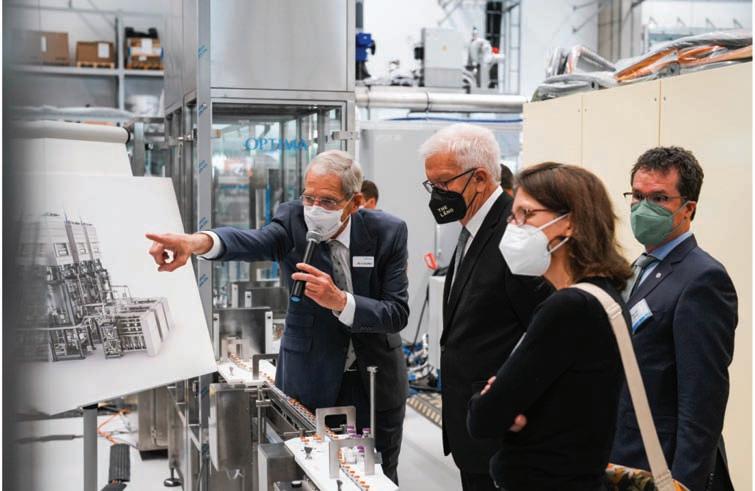
Expansion: Optima is investing in the Schwaebisch Hall headquarters
"This investment is once again reaffirming our commitment to the Schwaebisch Hall site, and, even in uncertain times, we are creating the conditions for continued growth and new jobs with confidence," says Hans Buehler, Managing Director/CEO, Optima Group. Winfried Kretschmann, Minister President, Baden-Wuerttemberg, made a special trip to the company's 100th anniversary celebrations to see for himself the facilities that are so crucial in the fight against the COVID-19 pandemic. "Companies like Optima are beacons. They embrace every challenge, are constantly reinventing themselves and continue to put their heart and soul into their work – and have done so for 100 years. When it comes to the process of transformation that is so profoundly shaping our economy, digitalisation and sustainability, they have taken up the reins, and in doing so have given Baden-Wuerttemberg a boost as a location for innovative companies," said the Minister President in his address.
The Consumer Business
Unit also received a number of huge orders in 2022, which requires a lot of space for the complex systems needed. To do this, additional space has been leased, including the former solar factory in Schwaebisch Hall's Solpark industrial park. To handle a historically large order in the food sector with several filling and packaging assembly lines, Optima specially refurbished the building extensively and created optimal working conditions.
Expansion: Expanding the service coverage in North America
In addition, Optima is continuing to expand its service coverage around the world. One example of this is Optima Pharma's new service hub, which opened midyear in Raleigh, North Carolina. The company is offering comprehensive on-site services, equipment and spare parts sales as well as comprehensive training programmes. With these
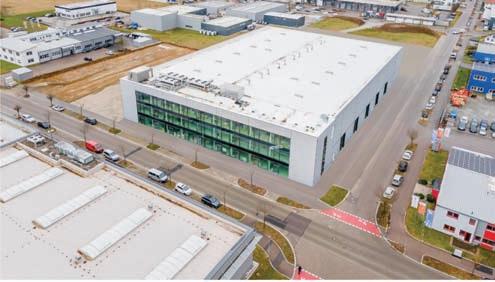
measures, Optima offers customers even better and faster support, both remotely and directly on site.
Responsibility: In 2022, Optima underscores its sustainabilityambitions
As part of the company's 100th anniversary, the sustainability strategy entitled "We care for tomorrow" was published in mid-2022. It centres on three pillars – developing genuine packaging for a fully functioning circular economy, together with customers, using sustainable machinery and systems to manufacture efficiently and preserve resources, and becoming excellent in the areas of environment, social affairs and corporate governance. Optima has also entered into a strategic partnership with the company Weyhmueller – for more sustainable packaging development and production. This means that Optima can offer its customers complete solutions in order to package products more sustainably.
In late 2022, the EcoVadis rating agency awarded Optima the silver medal for this overall commitment. This places the Optima Group in the top 25 per cent of the companies rated by EcoVadis. The areas assessed were the environment, labour and human rights, ethics and sustainable commitment. Optima's sustainability strategy is assessed annually by EcoVadis to identify new potential initiatives and promote existing activities.
Responsibility: Local solidaritythrough youth development
Optima is also aware of its responsibility to the region where it is located. That is why the Optima kit deal
created to mark the milestone anniversary. Optima raffled off
EXPRESS PHARMA January2023 58 PHARMA PULSE
was
2022,the Optima Group celebrated its 100th anniversary with numerous guests,including Minister President Winfried Kretschmann.Headquartered in Schwaebisch Hall,Germany,the company is looking back on a century of innovation,expansion,partnership and responsibility
(From left to right) Hans Buehler,Managing Director/CEO,Optima Group,explains the operation of a pharma filling line to Baden-Wuerttemberg Minister President,Winfried Kretschmann,Jutta Niemann (Member of the State Parliament,Buendnis 90/Die Gruenen) and Harald Ebner (Member of the Federal Parliament,Buendnis 90/Die Gruenen). (Source: Optima)
The anniversarywas celebrated over two days in earlyJulywith an open air event and a familydayin a fitting setting in Schwaebisch Hall. (Source: Optima)
The opening of the newCSPE Center II (centre) means that Optima Pharma is growing its production area in the Schwaebisch Hall industrial park. (Source: Optima)
PHARMA PULSE
100 complete sets of kit to youth teams from all sporting disciplines from the Schwaebisch Hall and Hohenlohe areas. At a Schwaebisch Hall Unicorns soccer match, the kits were ceremoniously handed over. The event brought in almost 700 players from regional youth teams and their coaches to Schwaebisch Hall.
Optima is offering young people future-proof, multi-faceted apprenticeships and student placements. On average, Optima employs more than 150 trainees and students every year.
granted until now are beginning to falter, and we are becoming aware that everything happening in this world has diverse ramifications for each and every one of us. We will continue together to do everything in our power to shape Optima's future in a safe, flexible and innovative way," says Hans Buehler.
Innovation:
Optima is continuing to develop fuel cell manufacturing technologyand is receiving state funding

Optima 2022 has also invested boldly in research and development and launched innovative solutions. This year, research has continued into the automated production of fuel cells. This also makes Optima a provider of complete solutions for manufacturing fuel cells. As a consequence of climate change, hydrogen-powered fuel cells are being hailed as the climate-neutral drive technology of the future. The German state of Baden-Wuerttemberg is funding the construction of a new test facility in Schwaebisch Hall with money from the Future Hydrogen Programme BW. Baden-Wuerttemberg is looking to become a pioneer in hydrogen and fuel cell technologies.
Outlook: Embracing change as an opportunity
In many respects, people are currently talking more than ever about a turning point in history that is presenting a challenge to the entire economy and all of society. "Today, it's all about continuing to work together to shape the future – whether in terms of new markets and issues like digitalisation and sustainability or our highly-valued, trust-based cooperation with our customers and across the entire Optima Group. With all the opportunities and risks globalisation brings, it continues to be in a state of constant flux. Many things that were taken for
Press contact: OPTIMA packaging group GmbH Jan Deininger Group Communications Manager +49 (0)791 / 506-1472 jan.deininger@optima-packaging.com www.optima-packaging.com

About Optima
Optima supports companies worldwide with flexible and customer-specific filling and packaging machines for pharmaceuticals, consumer goods, paper hygiene and medical devices markets. As a provider of solutions and systems, Optima accompanies these companies from the product idea through to successful production and throughout the entire machine life cycle. Over 3,000 experts around the globe contribute to Optima's success. 20 locations in Germany and abroad ensure the worldwide availability of services. In 2022, Optima celebrates the company's 100th anniversary.
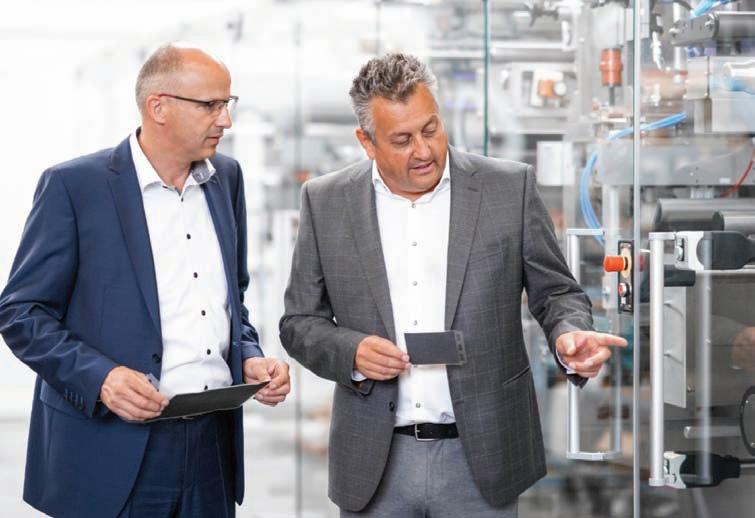
Exciting stories from 100 years of Optima: www.100-years-of-future.com

January2023 EXPRESS PHARMA 59
Optima has been using green electricitysince 2009 and has alreadymanaged to reduce its climate footprint by40 per cent as a result of other measures,like investing in photovoltaic systems.Afurther package of measures will reduce this byan additional 25 per cent by2030. (Source: Optima)
Werner Volk,Business Development Manager,Optima Life Science (left) and Juergen Bareiss,Head,Optima Life Science,in front of a fuel cell production facilitywhich is currentlyunder construction. (Source: Optima)
As a result of Optima's cooperation with the companyWeyhmueller,Optima is able to offer turnkeylines with in-line packaging production,filling and packaging that process environment-friendlypaper packaging solutions for consumer goods. (Source: Optima)
Qualityengineered rolling shutters from Gandhi Automations for better safetyand durability
Over years of meticulously working on the design,fabrication and installation,Gandhi Automations has developed technical expertise in manufacturing various kinds of automated rolling shutters

Rolling shutters have always been considered as one of the most dependable addition to any building due to its safety, durability, maintenance and ease of operation. Along with safety and other mentioned features to the building, it also provides optimal privacy without compromising the aesthetic appeal of the property. Modern rolling shutters are outperforming the traditional doors and erstwhile prototype rolling shutter option. This is due to its innovative designs, handiness and material strength which are far better than its earlier roller shutter models. Gandhi Rolling Shutters are ideal for situations where side room is at a premium and security is required. They require very little headroom above the structural opening. Their strength, elegance, durability and other salient features are designed for both external and internal applications.
Gandhi Rolling Shutters are fabricated of interlocking galvanised insulated and non-insulated profile, stainless steel profile, patented aluminum profiles and patented MS rolling grills.
Gandhi Automations, India’s No. 1 entrance automation and loading bay equipment company, is the only manufacturer of rolling shutters certified to ISO 9001: 2015, ISO 14001: 2015, ISO 45001: 2018 quality management system. This has resulted in the implementation of continuous improvement in personnel training, production technique, inspection, equipment calibration, machinery maintenance, logistics and customer relations. The product engineering team uses the latest software
combined with technologically-advanced machinery to offer to the customer a wellengineered product.
Over years of meticulously working on the design, fabrication and installation, Gandhi Automations has developed technical expertise in manufacturing various kinds
of automated rolling shutters. The Research and Development (R&D), team with its extensive know-how and experience, are able to produce specific types of rolling shutters unique to certain sites and client requirements. A consistent quality product has thus become the hallmark of
Gandhi Automations' manufacturing process right through installation to aftersales service.
Each of Gandhi Automations’ rolling shutters are designed to client's specifications and solidly constructed to promote trouble-free operation and long life. All rolling
shutters are automatic using vigorous drive expertise with manual override in case of power failure, and are dense, noiseless and dependable.
For further details, contact: Gandhi Automations Pvt Ltd Chawda Commercial Centre Link Road, Malad (W) Mumbai – 400064, India
Off: +91 22 66720200 / 66720300(200 lines) Fax: +91 22 66720201 Email: sales@geapl.co.in Website: www.geapl.co.in
EXPRESS PHARMA January2023 60 PHARMA PULSE
Gandhi Rolling Shutters are ideal for situations where side room is at a premium and security is required
Signet organises joint-technical seminar in collaboration with IFFand Meggle
The seminars were held in Mumbai and Hyderabad
Signet, along with its partners IFF and Meggle, organised technical seminars on 22nd and 24th November, 2022, in Mumbai and Hyderabad, respectively. The seminars served to be interactive platforms for technical discussion among 10 speakers and more than 200 attendees across the pharma industry.
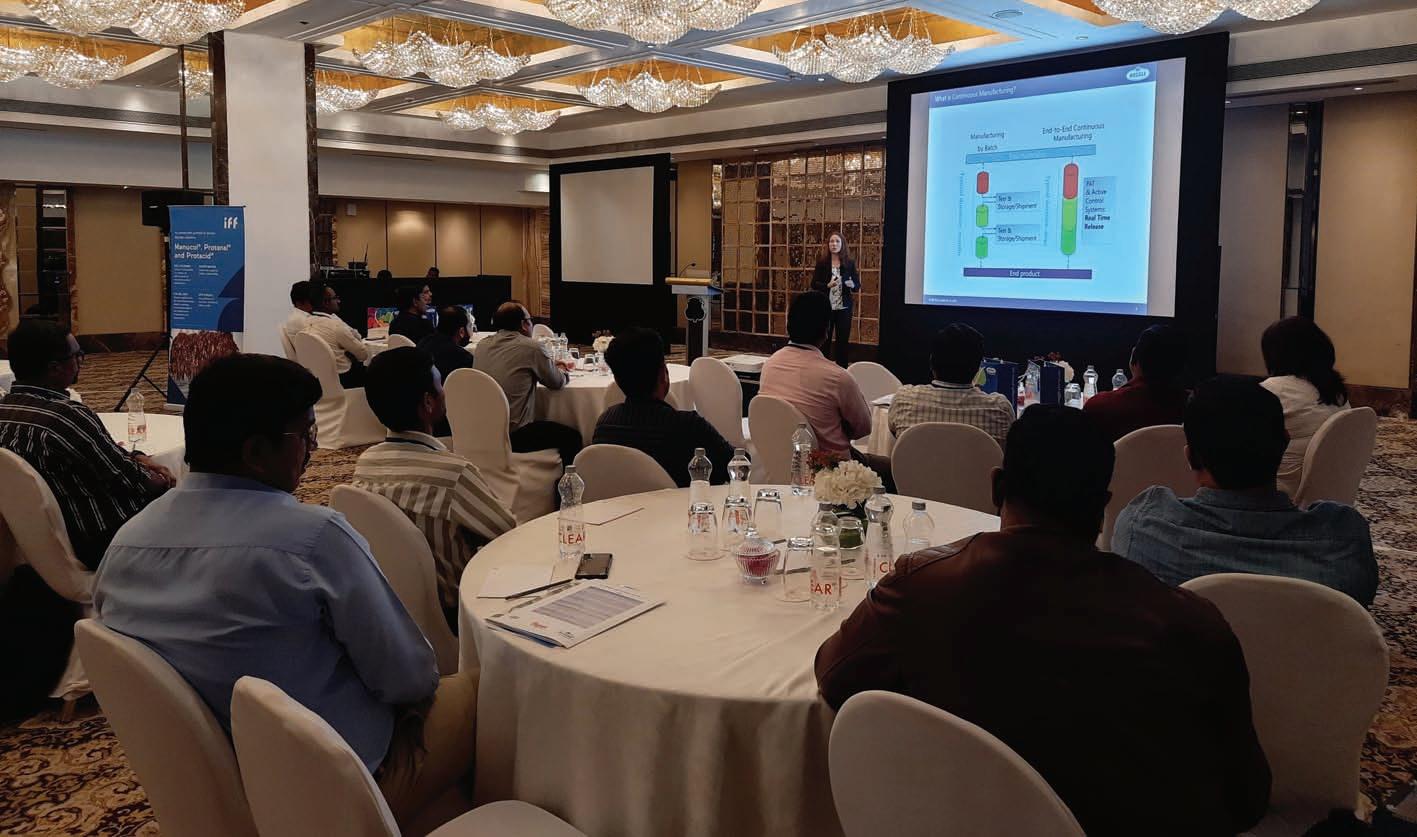
Speakers from Meggle included Dr Sonja Bauhuber, Application Manager, who elaborated on the concept of continuous manufacturing and its benefit. She also briefed on deformation behaviour of various excipients that largely impact tablet characteristics.
Pawan Zade, Regional Manager – South Asia and Prasad Gunjal, Technical Application Manager, explained advantages of lactose as an excipient in wet granulation and direct compression process and highlighted on selection of right grade of lactose based on formulation process.
Speakers from IFF included Dr Rina Chokshi, Global Commercial Marketing Director, who explained how operational excellence at IFF has helped in manufacturing of
superior quality Avicel and AcDi-Sol grades with utmost consistency. Paula Garcia Todd, Global Applications, Development and Inn ovation Leader, IFF, and Vinay Muley, R&D Leader, Pharma Solutions, IFF India, apprised on current
updates on nitrosamines.
Dr Tejas Gunjikar, South Asia, Pharma Application and Innovation Leader, IFF India, and Dr Sangamesh Torne, Application Development and Innovation Manager, IFF India, shared their insight on use of
alginates as a release modifier for sustained release application.

Dr Heeshma Shah, Director – Technical Services, Signet Excipients, spoke on efficacy of Avicel SMCC in resolving critical formulation concerns like
tablet compressibility, content uniformity and improvement of hardness.
With a positive feedback received from participants, the sessions proved to be a successful medium for knowledge exchange.
January2023 EXPRESS PHARMA 61
PHARMA PULSE
Testo 440 – The intuitive air velocityand IAQ-measuring instrument
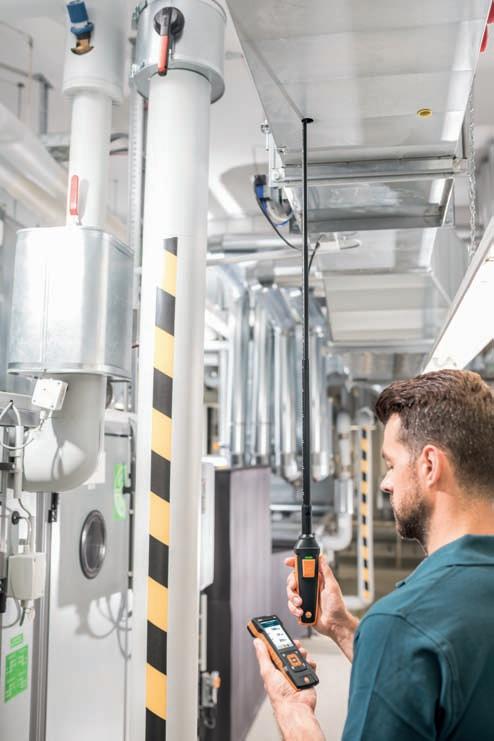
This
The new testo 440 combines the benefits of a compact hand-held device with intuitive measurement menus and a comprehensive selection of climate probes. This means you have all measuring tasks on air conditioning and ventilation systems reliably under control with just one versatile instrument. With variety of Bluetooth and wired probes as well as testo Smart Probes, testo 440 can measure parameters – temperature, humidity, CO, CO2, degree of turbulence, light intensity, differential pressure and air velocity. Customers have the choice between wireless and fixed-cable models. The wireless Bluetooth® probes ensure more freedom of movement in measurement and save space in the measurement case. In addition to this, a probe handle can be universally combined with all corresponding probes and probe attachments. This allows you to switch in seconds from indoor air quality measurement to a determination of volume flow at a vent. There is a right probe for every applicationin ducts, at outlets, in rooms, at filters or with Pitot tubes.

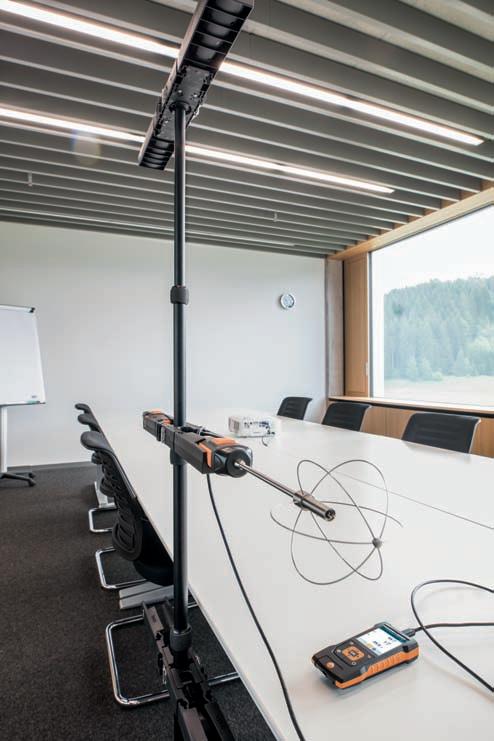
Product features:
◆ Can measure °C, %RH, CO, CO2, m/s, Lux
◆ Intuitive menu for important applications
◆ Compatible with a wide selection of Bluetooth and wired probes and testo Smart Probes
◆ Parallel display of three measuring values
◆ Universal probe handle with Bluetooth
◆ Memory recall on instrument for up to 7,500 measurements
pressure for measuring hPa
Testo 440 dP model version with integrated differential
◆
For more details login to www.testo.com or write back to info@testo.in
EXPRESS PHARMA January2023 62 PHARMA PULSE
means you have all measuring tasks on air conditioning and ventilation systems reliably under control with just one versatile instrument
Tired of tedious manual plasmid DNApreparations?
Plasmids are one of the cornerstones of modern biology, providing the foundation for several areas of important research including DNA vaccines, mRNA vaccines, viral vectors and monoclonal antibodies. This small, circular DNA is found in bacterial cells and is used widely as a vector for specific DNA fragments across multiple fields, including molecular biology, biochemistry, biotechnology and cell biology. Plasmid purification, therefore, has a wide range of applications and its importance is reflected in recent scientific triumphs, including the development of COVID-19 vaccines and advancements in gene and cell therapies.
Plasmids that are used in a lab setting have been designed to introduce a DNA fragment into another cell via the use of cloning methods. They are attractive tools for scientists as they are easy to modify and can self-replicate within a cell. As a result, plasmid purification is a fundamental technique used every day in labs all around the world.
One of the most widely used applications of plasmids is in transient transfection which results in the mass production of proteins and viral vectors. Through this technique, plasmids enable mammalian cells to express the protein that is coded by the gene they carry. Plasmids produced for transfection studies also need to be of very high quality and relatively pure for successful transfections to take place, which can also be time-consuming. While there have been numerous advances in other aspects of the production of mammalian proteins, plasmid purification technology has remained unchanged for over 40 years, but
all this is about to change with the introduction of Biotage's PhyPrep Plasmid Purification system which can simplify and streamline the plasmid purification process, saving both time and money, and providing better quality results.

Plasmid purification challenges
Before we dive into Biotage's PhyPrep Plasmid Purification system, you may be wondering what the issue is with the techniques currently in use in lab settings across the globe,
have not been changed in over 40 years. Well, to start, largescale plasmid purification is a long, drawn-out process that can take days in the lab or weeks if it is outsourced. There are also several challenges that we can highlight that are associated with developing and purifying plasmids for scientific studies, especially when the amount of plasmid required is in the maxi-, mega-, or giga-scale. Firstly, plasmid purification is not only a labour-intensive process that involves multiple steps such as centrifugation, lysis of cells and chromatography, but it also involves a lot of time spent at the bench carrying out repetitive and monotonous tasks. This highly laborious process involves the addition of multiple reagents which leaves a wide margin for human error. Secondly, the purification step has additional challenges including removing contaminants such as RNA, host cell DNA, and endotoxins as well as cell debris. Plasmids typically represent less than one per cent of the dry cell mass. So, there are a lot of potential contaminants that are struc-
DNA that need to be removed. In addition, when producing plasmids on a large scale, there is also a large cell pellet which can be difficult to resuspend. When we look at all this together, it’s clear that plasmid purification is a long and tedious process with multiple steps that leave room for several errors to be made, potentially compromising the quality of the plasmids produced. With all this in mind, Biotage has developed an au-

turally similar to plasmid
tomated process that simplifies the mass scale plasmid purification process, offering high quality and consistent results every time. The PhyPrep plasmid purification process can address all your mass protein production needs as it is purely for maxi-, mega-, and giga-scale plasmid purification. It is transfection grade and endotoxin-free and is straightforward to use. Let's look at how it works.
Introducing Phyprep Biotage introduces the

January2023 EXPRESS PHARMA 63 PHARMA PULSE
especially if these techniques
Plasmid purification has a wide range of applications and its importance is reflected in recent scientific triumphs,including the development of COVID-19 vaccines and advancements in gene and cell therapies
PHARMA PULSE
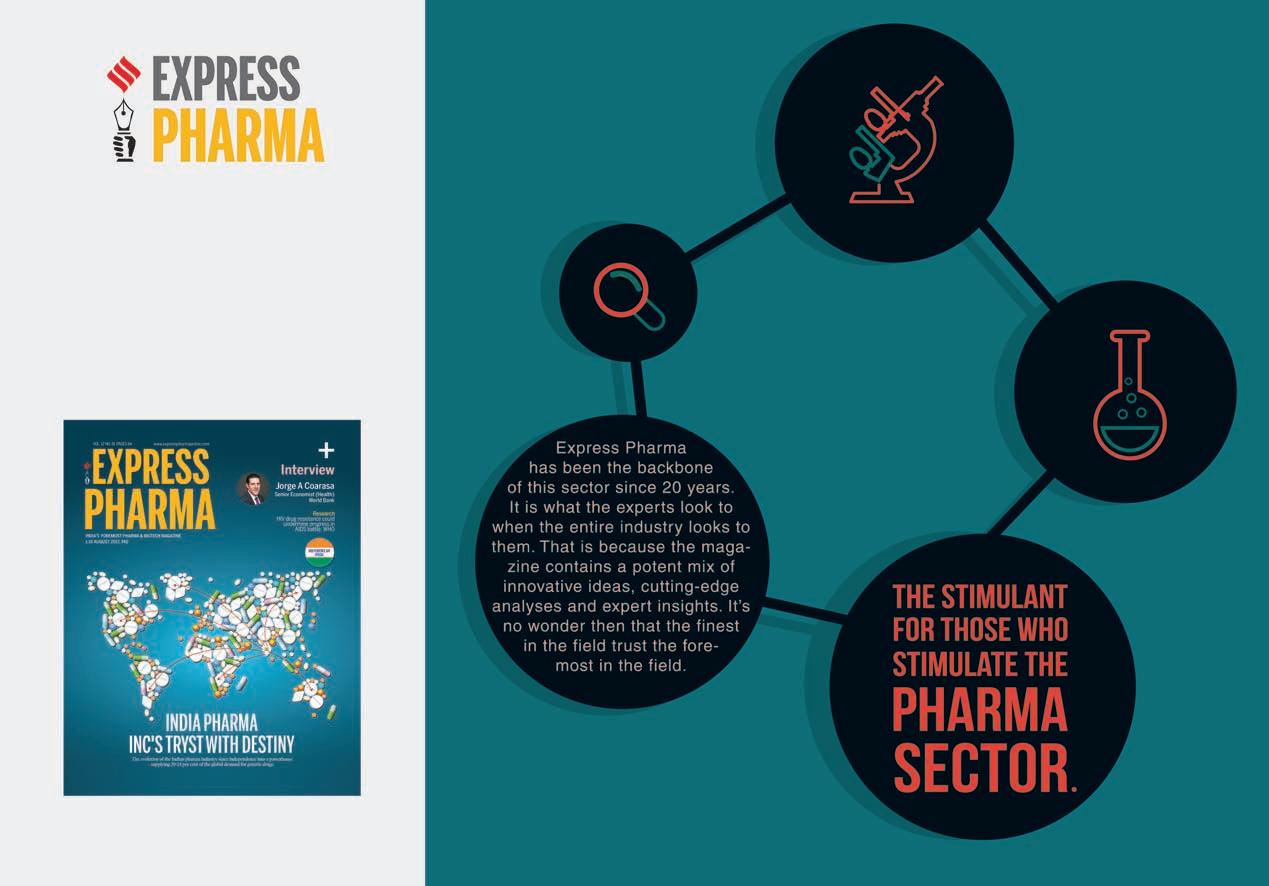
PhyPrep System, the only automated plasmid purifier capable of operating on the maxi-, mega- and giga-plasmid-preparation scales. The result is highly pure, endotoxin-free*, supercoiled plasmid DNA – the optimal starting point for downstream applications, such as transient transfection. PhyPrep comes with everything needed to generate highly pure plasmids, from a simple sample preparation step to a fully automated walkaway solution, freeing up one’s time to get on with the really important work – scientific research.
Automated plasmid purification
The PhyPrep instrument is both simple and robust, and requires less than eight minutes of one’s time for sample preparation, but how exactly does it work?
This system makes use of dual-flow chromatography technology which is highly reproducible and easy to automate. Dual-flow chromatography involves using a pipette tip column that is packed with resin. The sample is loaded and flows back and forth in a slow and highly controlled manner.
High reproducible yields of
up to 1 mg for MaxiPrep, 5 mg for MegaPrep and 10 mg for GigaPrep can be achieved. Purification performance and transfection efficiency is comparable to the leading manual plasmid preparation alternatives available in the market.
The automated plasmid purification allows the users to spend their time on other activities and return once the plasmid purification has been completed. The resulting plasmids are pure, endotoxin-free and supercoiled which is an important criterion for transfection efficiency.
Whychoose PhyPrep?
The PhyPrep instrument is a fast and efficient machine that enables researchers to produce plasmids using an automated system that results in high-quality plasmids the very same day. Our instrument produces quality plasmids consistently and removes the need for long, laborious days in the lab. The workflow, kit and software are easy to use, enabling one to devote less time to monotonous plasmid purification and more time to those tasks that you often struggle to fit into your day. In addition, it is cost-effective and reliable, and allows one to
have complete control over the whole process.
Therefore, manual plasmid purification can be a tedious, repetitive and time-consuming process. Automating this workflow enables one to make more effective use of one’s valuable time. Biotage® PhyPrep system increases the productivity and efficiency of one’s laboratory, vastly simplifying plasmid purification with results better than ever.
Read more at www.biotage.com ; https://www.biotage.com/phyprep
For any queries, please mail at india@biotage.com
EXPRESS PHARMA January2023 64
PHARMA PULSE
ABSTRACT
In the past years, the pharma and healthcare industry has witnessed tremendous growth and there have been tie-ups with a number of multinationals for production and R&D facilities to be nurtured in India. Organisations are applying for ISO standards and upgrading themselves to the latest norms related to health and hygiene.
Microbial contamination and pollution play a significant role in the pharmaceutical industries. Control of microbes has always been the biggest challenge to these industries. A load of microbes are present in areas such as production, storage/packaging, R&D, Q.A/Q.C., filling etc. They are present everywhere in the air, surface, water, instruments, linens etc.
Hence the disinfectant used should be so precise that it should not only take care of the microbial contamination but also be user and eco-friendly. Virosil Pharma meets all the required standards for the pharmaceutical industry.
ABOUTUS
Sanosil Biotech, a Mumbaibased company, has launched a range of multipurpose disinfectants which are eco-friendly, chlorine-free and completely biodegradable and have applications in the pharma and healthcare industry as well as in the food processing industry. It is manufactured in India in technical collaboration with SANOSIL AG of Switzerland.
SANOSIL AG in Switzerland is the patent holder and has joint venture agreements in more than 15 countries such as France, Italy, Spain, Holland, Norway, South Africa, Australia, Saudi Arabia, Oman, the UAE, etc. The product is being used in various countries by reputed institutions and has been thoroughly tested under
strict regulations imposed by European Health bodies.
PRODUCTDISCRIPTION
Virosil Pharma is a multicomponent fumigant and disinfectant. The oxidizing agent used is hydrogen peroxide, which is bonded with stabilizing agents to form a complex solution. A long-lasting effect is ensured by the addition of silver, which acts as a catalyst in trace amounts. The bactericidal effect of silver is based on the fact that the monovalent silver
ion Ag+ binds very firmly to bacterial proteins by a covalent or co-ordinate bond, and thus inactivates or precipitates these.
◆ Its effectiveness against bacteria, viruses, amoebae, fungi and algae; i.e. its extremely wide range of application makes it easy to handle for the end user; i.e. only one product is needed, where so far 2, 3 or various products were necessary.
◆ Owing to the good stability of the product, a long storage
USFDADRAFTGUIDELINES
WHO
time can be guaranteed. As the product remains stable at high water/air temperatures, and as its effectiveness is even increased at high temperatures.
◆ Due to its long-term effectiveness and pronounced characteristics to prevent recontamination, this product is perfectly suited for disinfection of drinking water and wells.
ter, because it breaks down into water and oxygen (H2O and O2), i.e. it produces no noxious by-products.
◆
Virosil Pharma is ecologically harmless. Its principal constituent - hydrogen peroxide - does not pollute waste wa-
◆ The two basic substances (H2O2 and Ag) enhance their advantages (*synergism). The bactericidal effect comes into action quicker and more intensively than if either substance was used on its own. Fumigation with Virosil Pharma,the
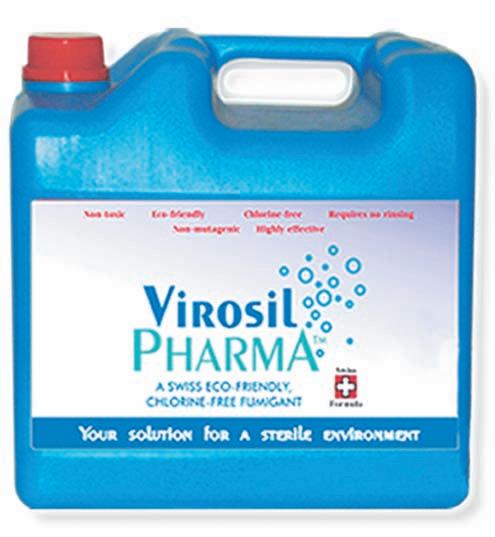
January2023 EXPRESS PHARMA 65
Fumigation
the most
Pharma: Arevolutionary,eco-friendlyfumigant Virosil Pharma has proved to be effective in controlling aerial bacteria and fungus present in sterile rooms.The area becomes completely sterile within 60 minutes of spraying without causing any irritation to the eyes,nose and skin - unlike conventionally used formulations ADVANTAGES #Eco- friendly- It is totallybiodegradable since (H2O2) breaks down into water & oxygen #Chlorine free #Non-toxic (no irritation to skin or eyes #No effect on pH #Non carcinogenic and non mutagenic #Excellentlyrinseable with no remains PROPERTIES #Can easilybe dosed # Does not foam # Decomposes into water and oxygen # It is excellentlyrinseable with no remains # Treats anyother material with consideration
GMP2002 Grade Air sample cfu / cu.m. Settle plates (90mm) cfu / 4 hours Contact plate 55mm cfu / plate Glove print Cfu/glove A < 1 < 1 < 1 < 1 B 10 5 5 5 C 100 50 25D 200 100 50 -
perfect Salternative to Formalin
is one of
Virosil
EU
2002 MICROBIALLIMITS Grade Max.no.of microorganisms permitted / m3 A Less than 1 B 5 C 100 D 500
Clean Area Classification Microbial limit Cfu / 10 cu.ft. Microbial limit Cfu / 10 cu.m. 100 < 1a < 3a 1000 < 2 < 7 10,000 < 5 < 18 100,000 <25 <88 a=samplesfromclass100environmentsshouldnormallyyieldno microbiologicalcontaminants
PHARMA PULSE
important factors associated with pharma industries, it plays a vital role in maintaining the sterility of areas and is directly related to production.
Sanosil Biotech is the first company to pioneer the novel concept of eco-friendly fumigation. The company has great respect for human health and the environment. The CEO, Dev Gupta, an MBA from the Bentley Graduate School of Business, Boston, has been actively marketing the brand nationally. According to Gupta, "Virosil Pharma has simplified the lives of so many people who work in the pharmaceutical industry as they are guaranteed sterility with the minimum risk exposure". As there was a high risk to the staff involved in the use of Formaldehyde/Glutraldehyde for sterilization and disinfection.
Owing to the stringent integrated micro contamination control and biosafety requirements, it is desirable to have micro-contamination control procedures and methods that could be monitored, evaluated and assessed periodically, which are convenient, cost-effective and safe.

A glimpse at the standards put down by various would monitoring agencies would help an individual or an organization help decide on choosing the most appropriate control procedure/methods. The important microbial limits which have been prescribed by various agencies is as follows:
To meet those requirements aerial disinfection (fumigation) with formaldehyde was the most convenient method. With the regulatory having restricted the use of formaldehyde and also putting into place the monitoring levels of formaldehyde after fumigation makes it a procedure with its own limitations.
Formaldehyde is a known carcinogen (IARC & NTP). Formalin is toxic by inhalation, toxic if swallowed, may be fatal if swallowed, causes eye burns, may cause blindness, strong sensitizer, causes irritation to skin, eyes, and respiratory tract. Repeated or prolonged exposure increases the cancer risk.
Virosil Pharma has been a direct alternative to Formalin Fumigation. Virosil Pharma has proved to be effective in controlling aerial bacteria and fungus present in sterile rooms. The area becomes completely sterile within 60 minutes of spraying without causing any irritation to the eyes, nose and skin - unlike conventionally used formulations. Virosil Pharma can even be successfully used in AHU which are responsible for optimal and steady air exchange in production facility, of which the ducts, air shafts, humidificator, filters, etc. are often contaminated with loads of bacterial and bio-films.
The main aim of Virosil Pharma is to increase productivity by cutting down disinfection time while at the same time providing a totally microbe-free environment.
Virosil Pharma is also very effective in disinfection of all critical surfaces that come in contact with pharma products. There is no requirement to rewash equipment and surfaces disinfected with Virosil Pharma since it is H2O2 based and decomposes into water and oxygen.
Virosil Pharma has been tested by several reputed and renowned institutions in India with respect to its disinfection and fumigation applications in Pharmaceutical Industry
Because of all these factors, Virosil Pharma has attained maximum satisfaction of the customers in controlling the microbial contamination in their respective applications. The introduction of an ecofriendly, non-carcinogenic and totally biodegradable versatile product, like Virosil Pharma,
has not only brought an end to the era of conventional biocides but has completely solved the disinfection requirements which these healthcare industries were prone to.
Targets
Sanosil Biotech is marketing this disinfectant under the 'Virosil Pharma' brand name and is targeting the entire industrial belt of India. The com-
pany has already set up a distribution and infrastructure network having establishments in Maharashtra, M.P., Hyderabad, Chennai and Delhi.
EXPRESS PHARMA January2023 66
S.AUR B.CER E.COLI P.AER C.ALB
Highlytoxic
gets sterilized within 1 hour after fumigation Requires
Requires
Requires
can be
during fumigation Causes
even after next dayof fumigation
Saving Time consuming Multiple Applications Application restricted
DISINFECTANTEVALUATION DATA- VIROSILPHARMA Organism Type
2.50% 429.83 397.4 418.15 289.38 0 3.00% 514.44 502.4 440.92 349.48 0 4.00% 615.44 683.14 490.625 404.5 0 5.00% 669.32 1063.07 580.77 452.16 0 COMPARISON VIROSILPHARMA FORMALIN Eco-friendly,Non-toxic
Room
overnight fumigation
no de-fumigation
de-fumigation Person
present
skin,eye irritation
Time
AGRAPHICALVIEWON




www.idealcures.com +(91)-(22)- 4268 8700 Ideal Cures ‘High Performance Aqueous Film Coating System’ • 50% process time savings when compared with traditional cellulosic coatings • Three fold increase in adhesion properties with optimum finish • Doubled production output with cost and time saving REGD.WITH RNI NO.MAHENG/2005/21398,POSTAL REGD.NO.MCS/164/2022 – 24,PUBLISHED ON 5TH EVERY MONTH, POSTED ON 9TH,10TH,AND 11TH EVERY MONTH POSTED AT MUMBAI PATRIKA CHANNEL SORTING OFFICE,MUMBAI – 400001




























 By EPNews Bureau
By EPNews Bureau



























































































































